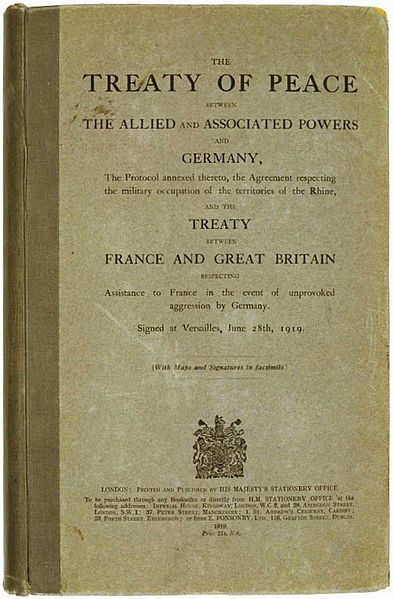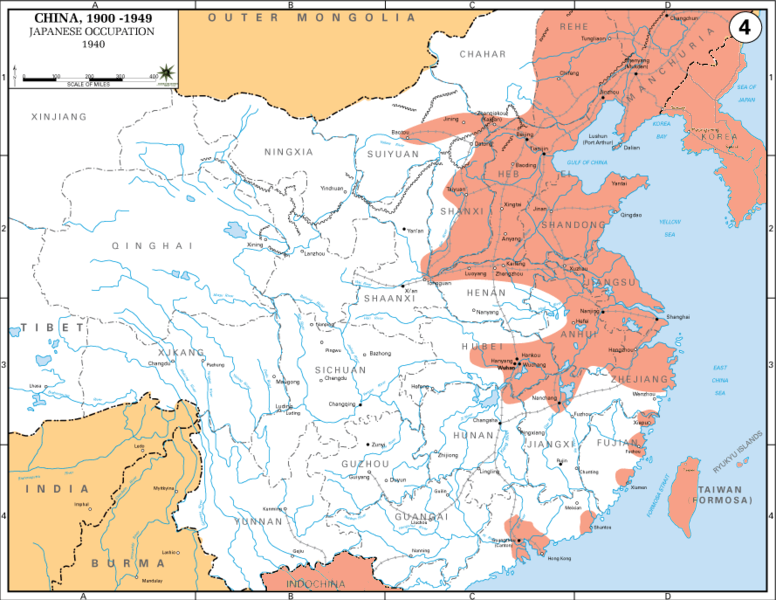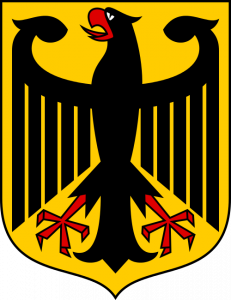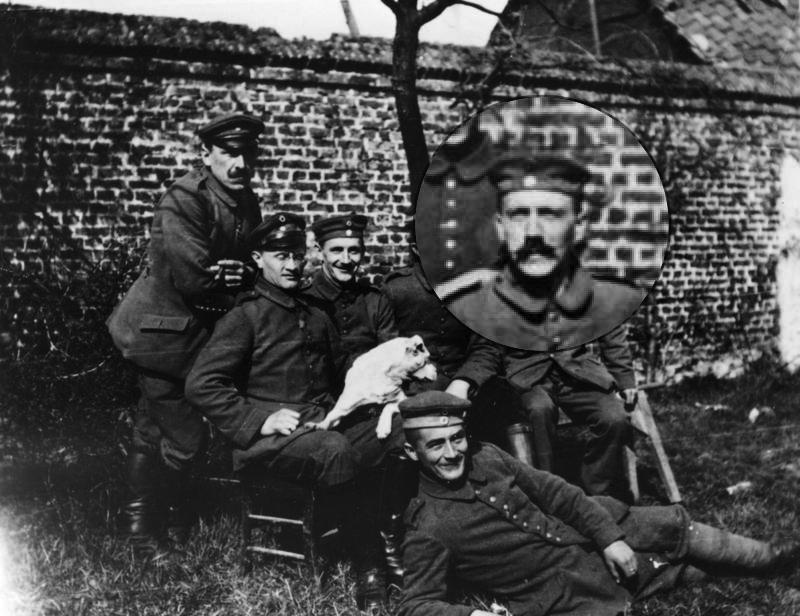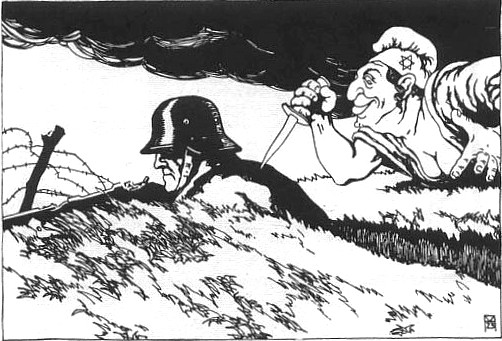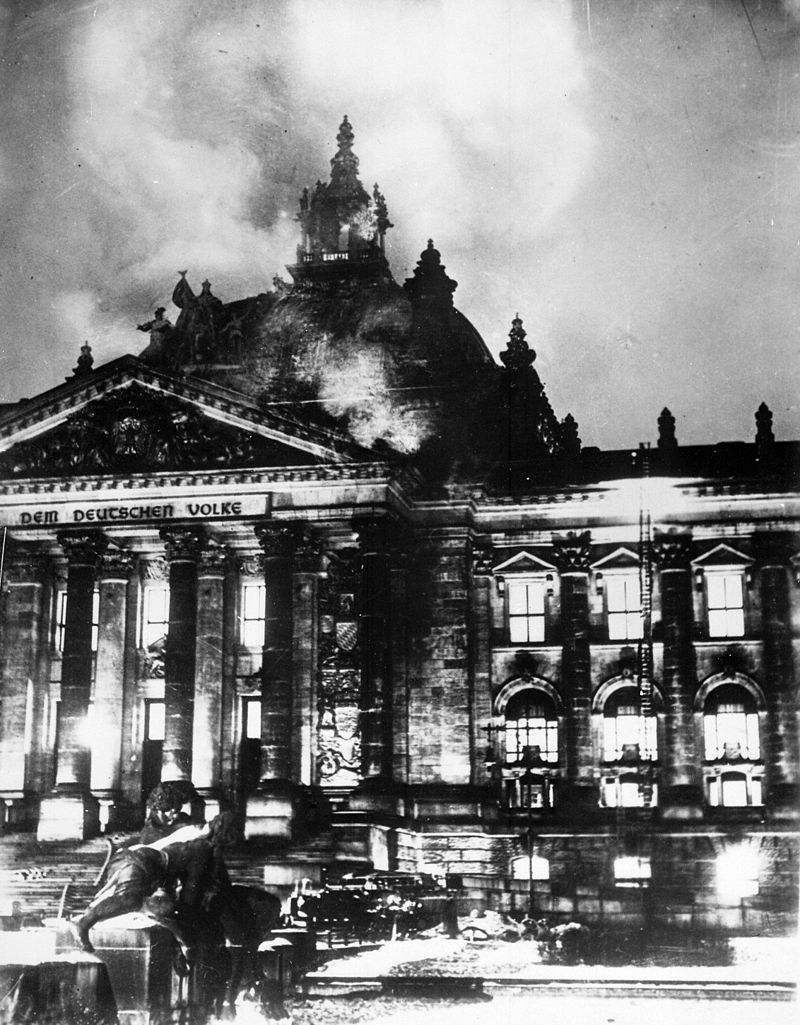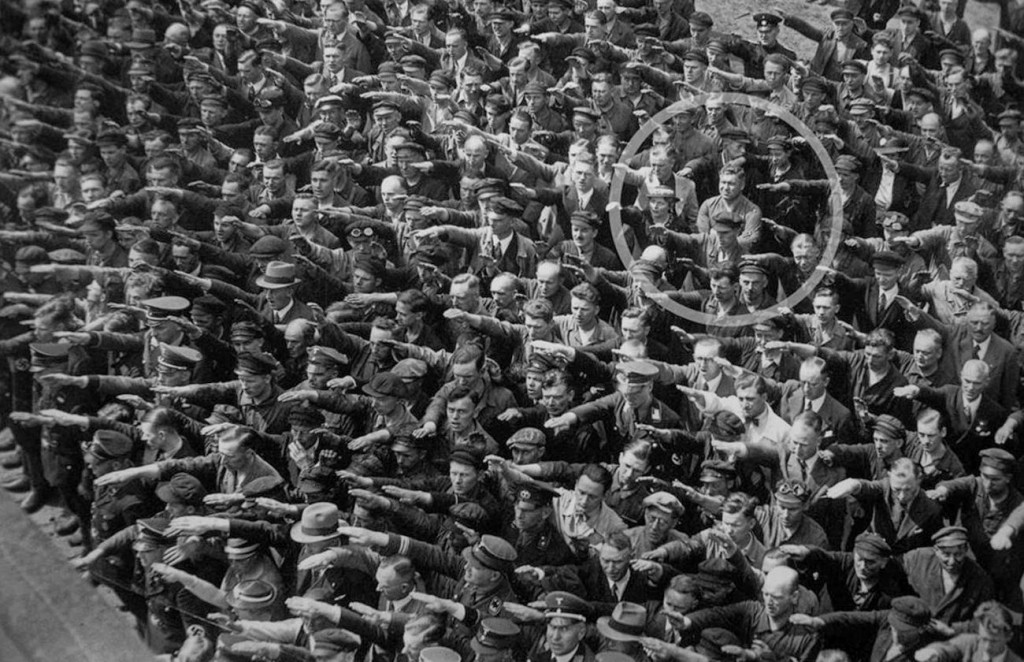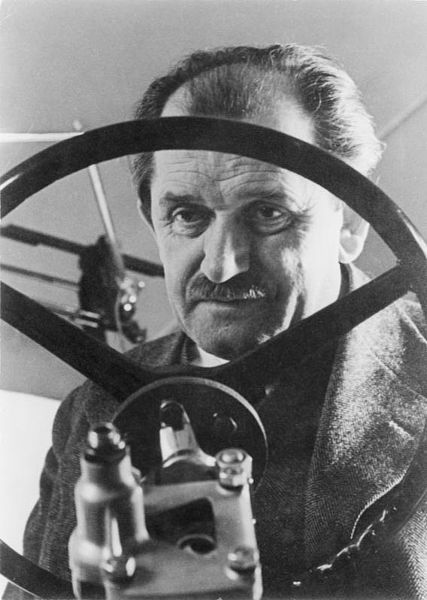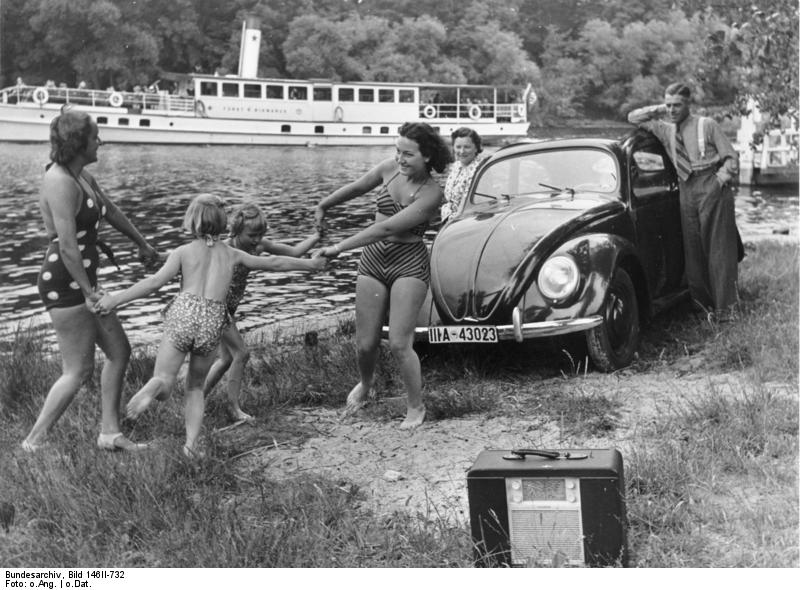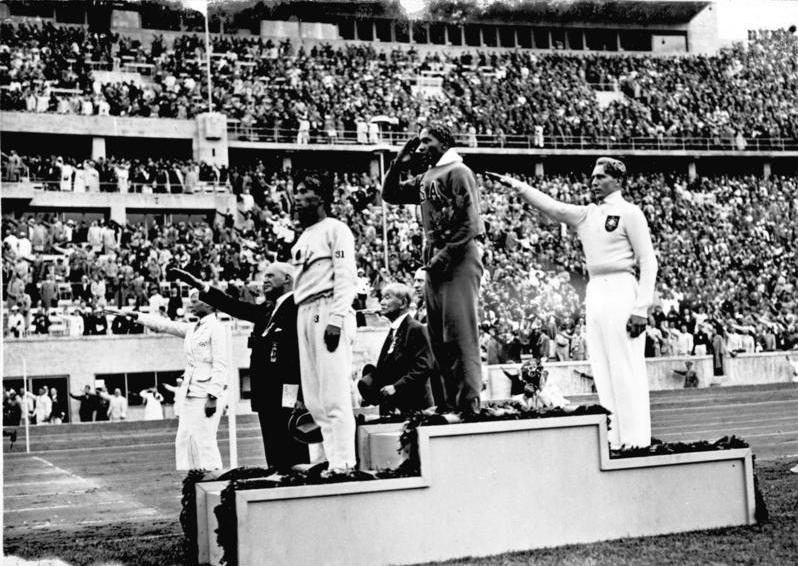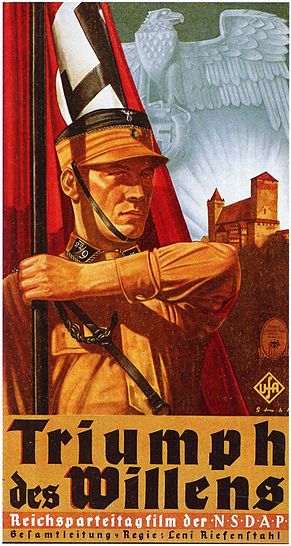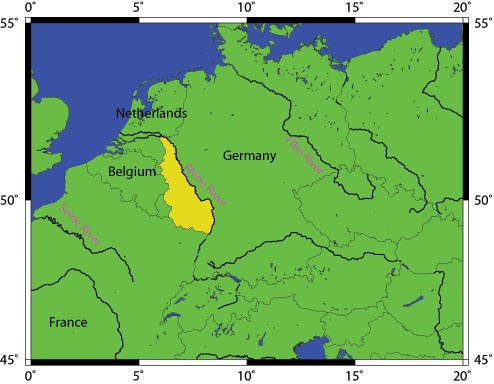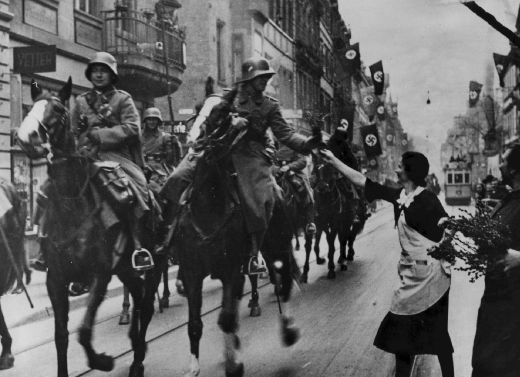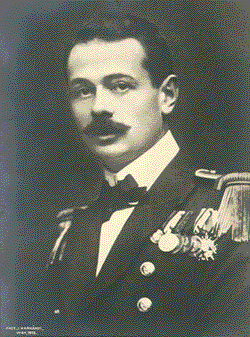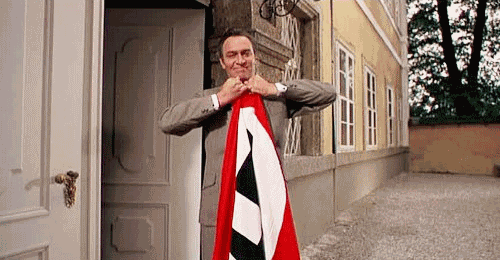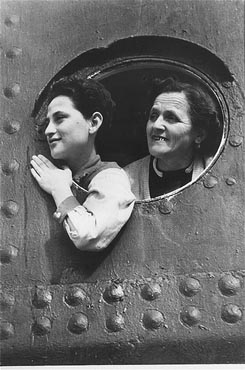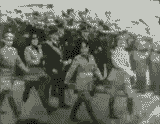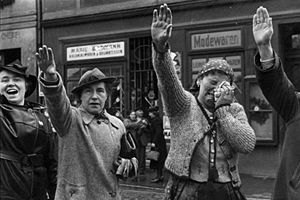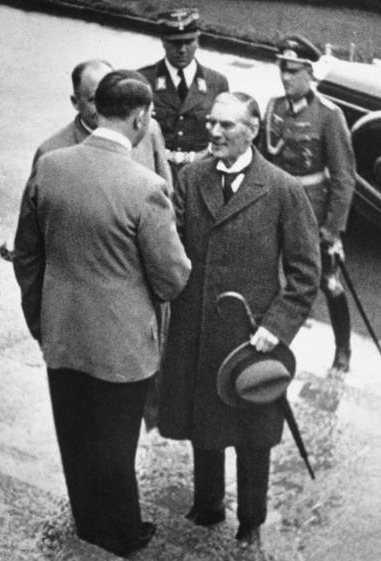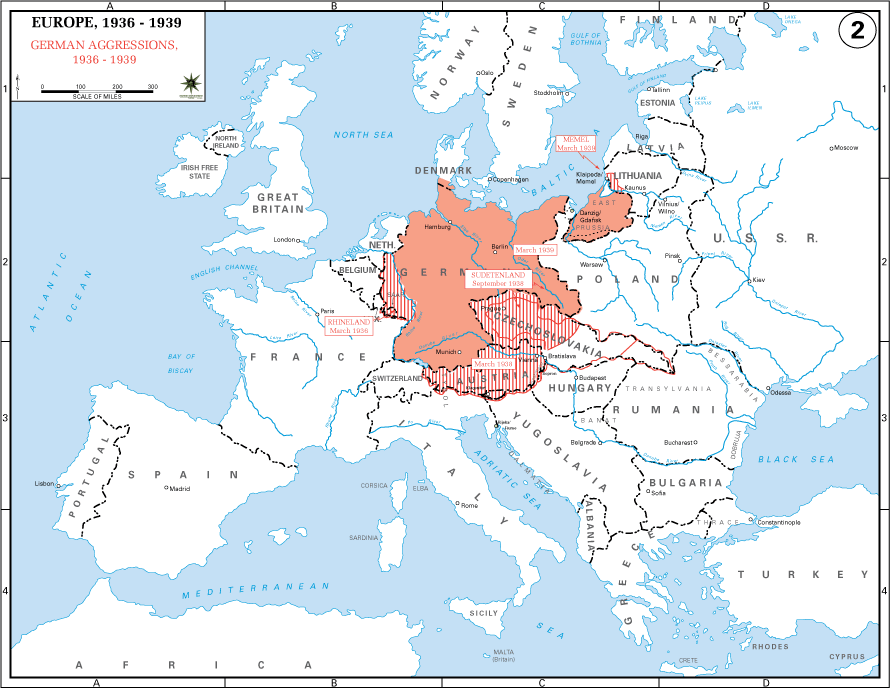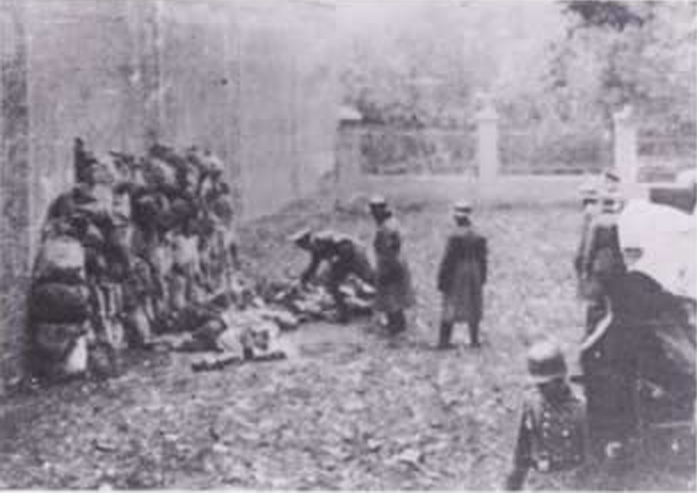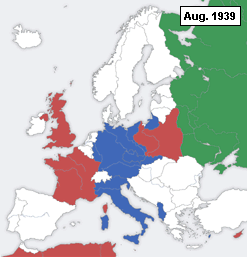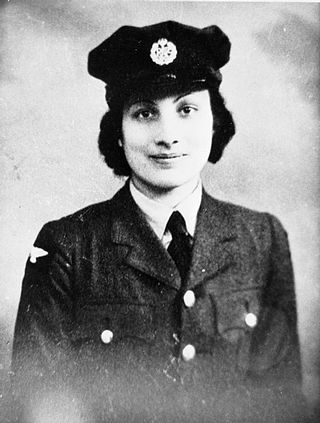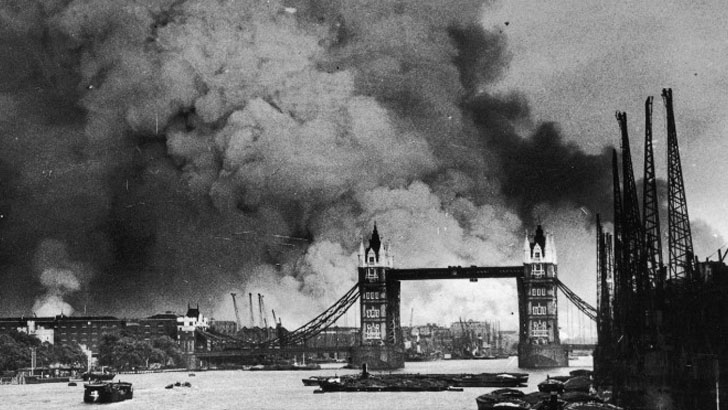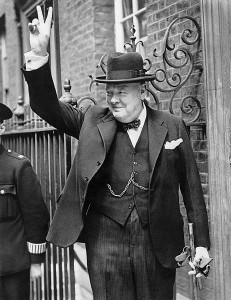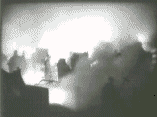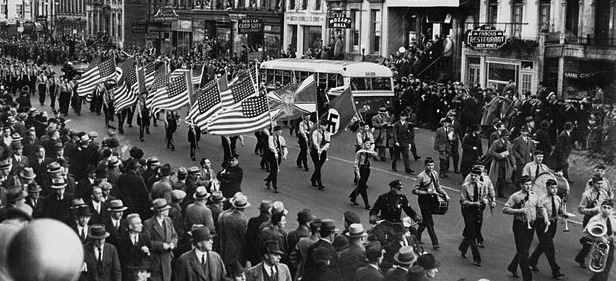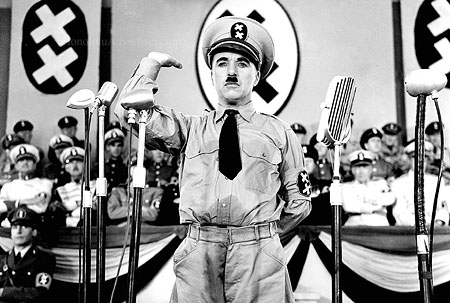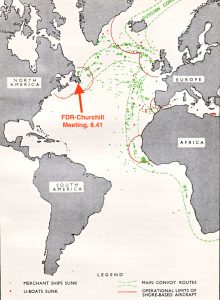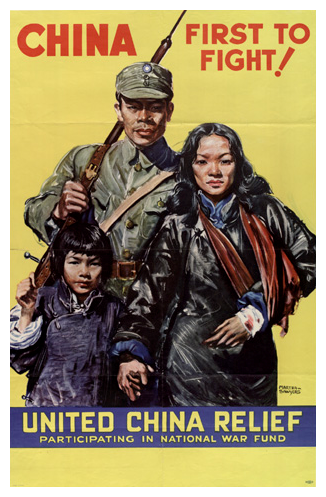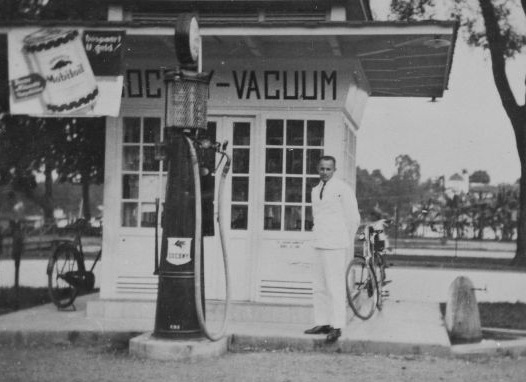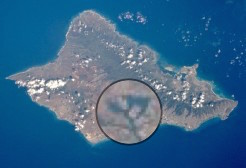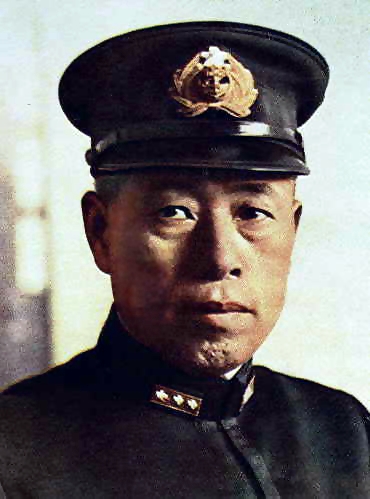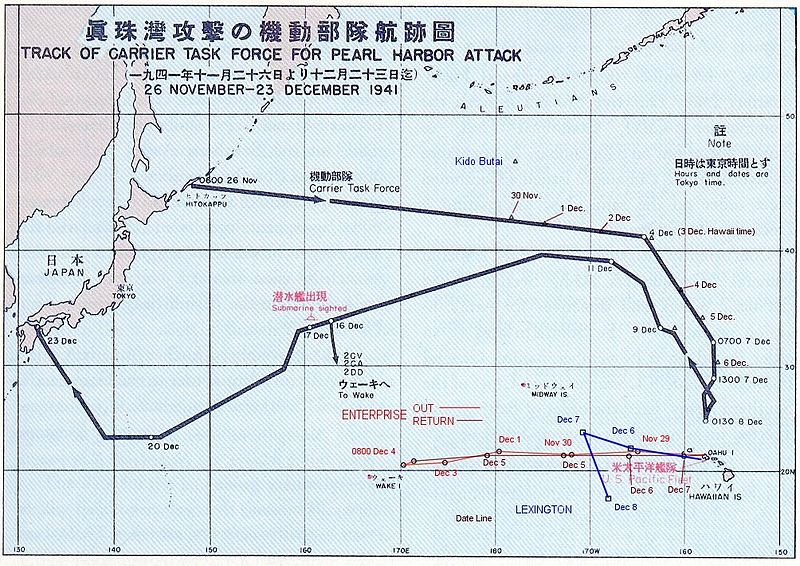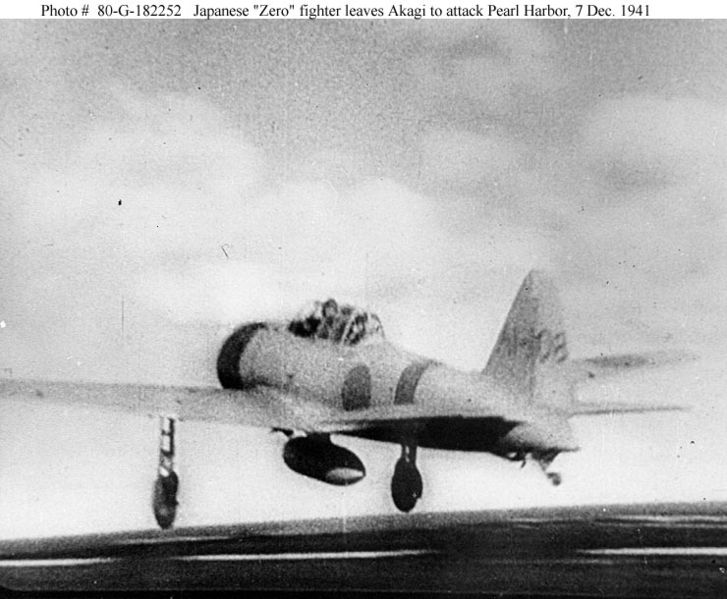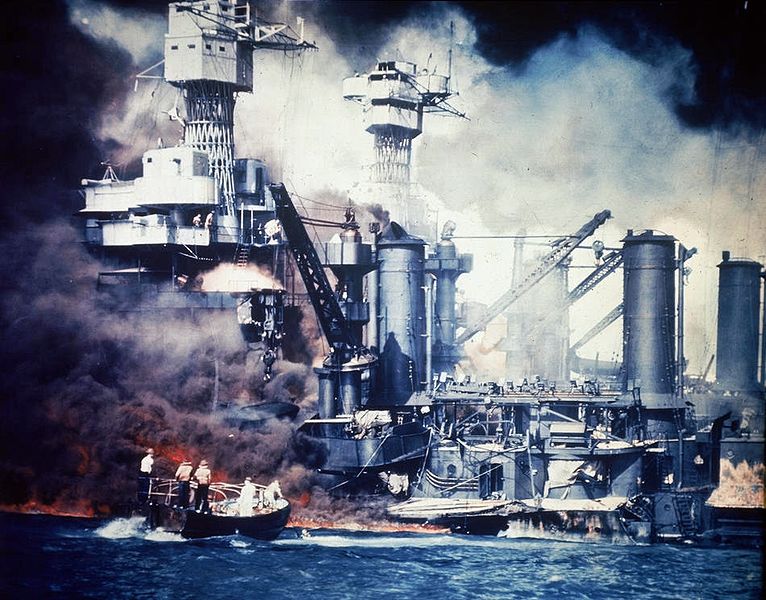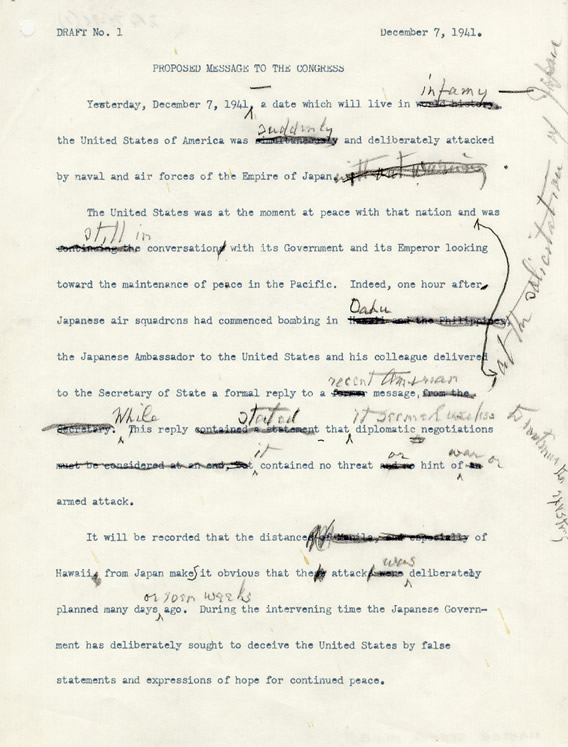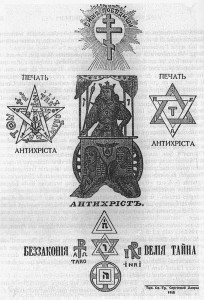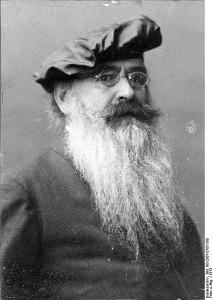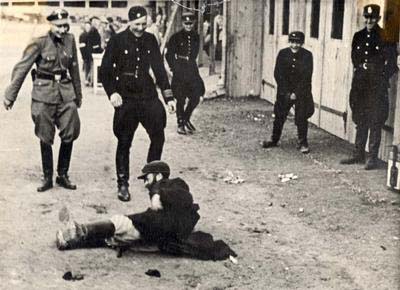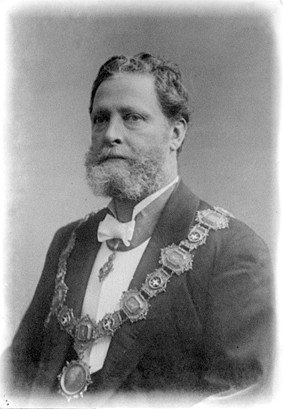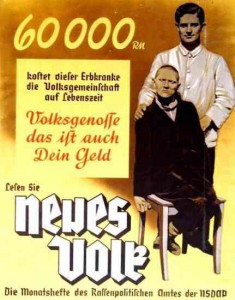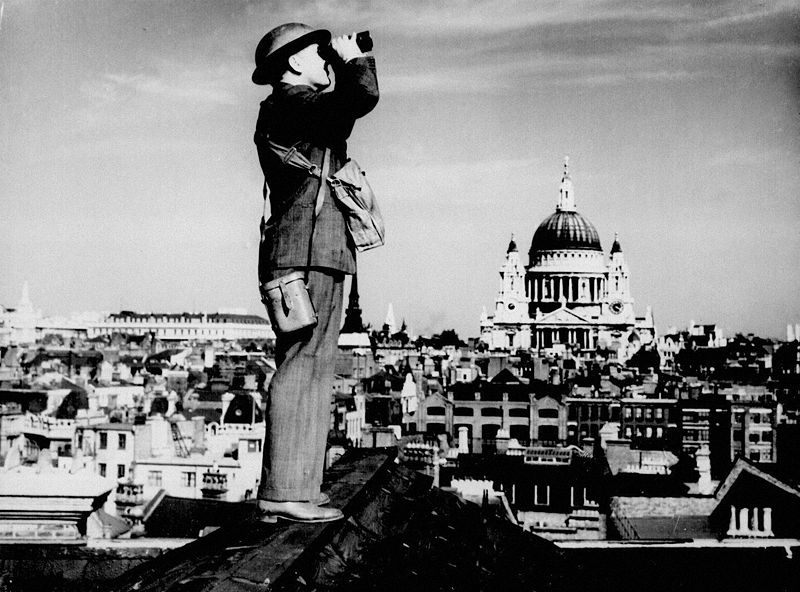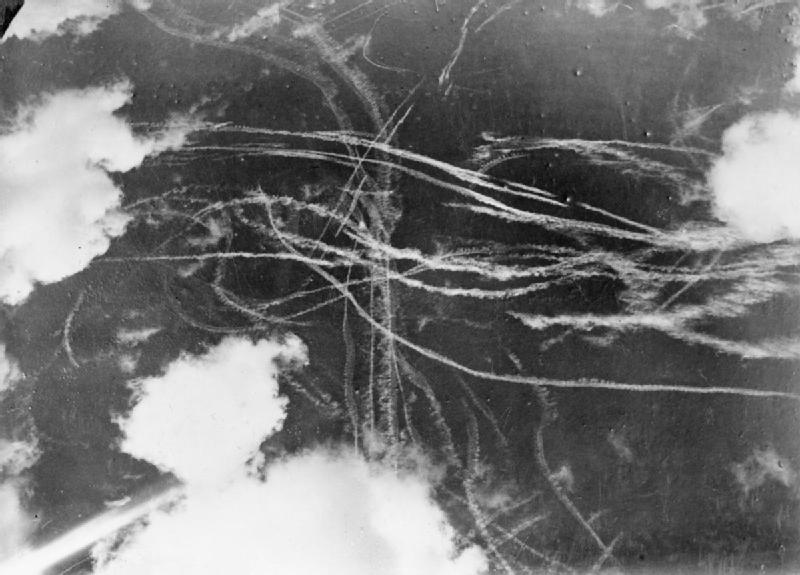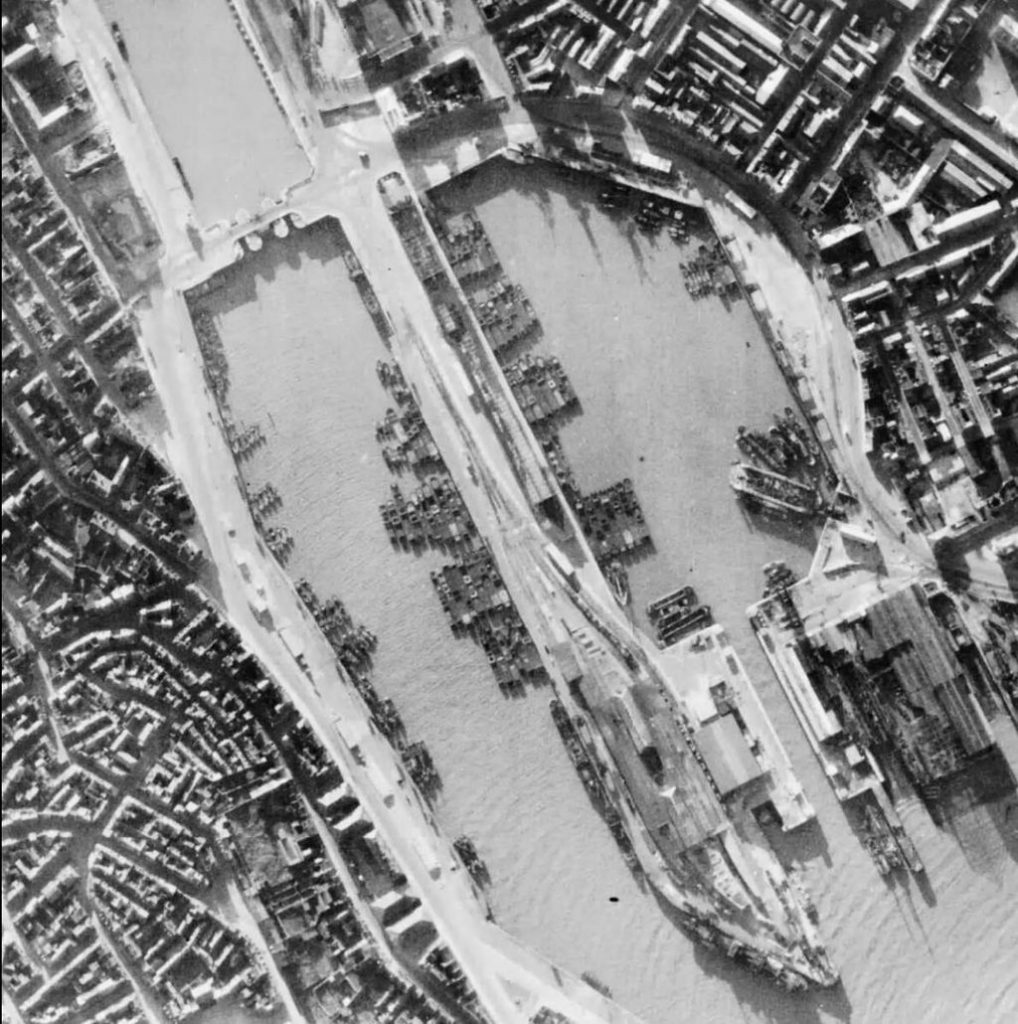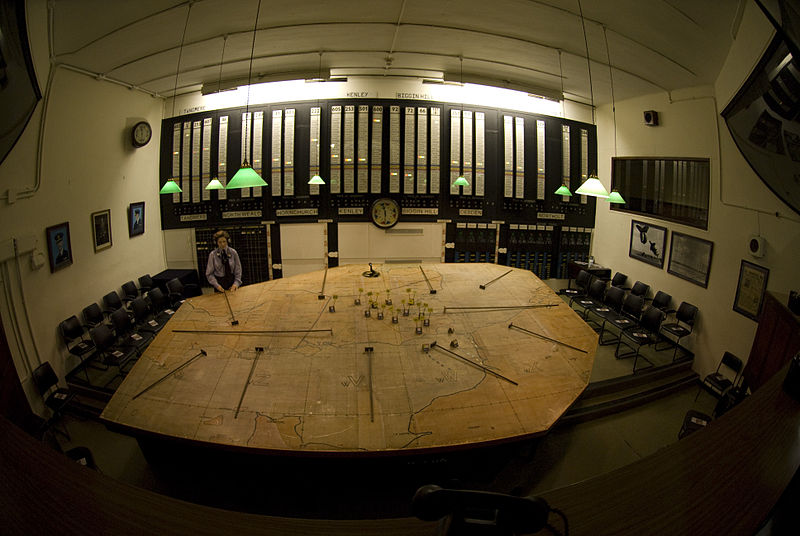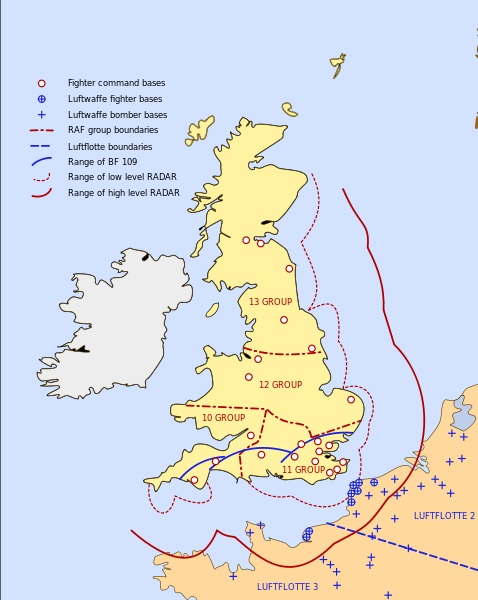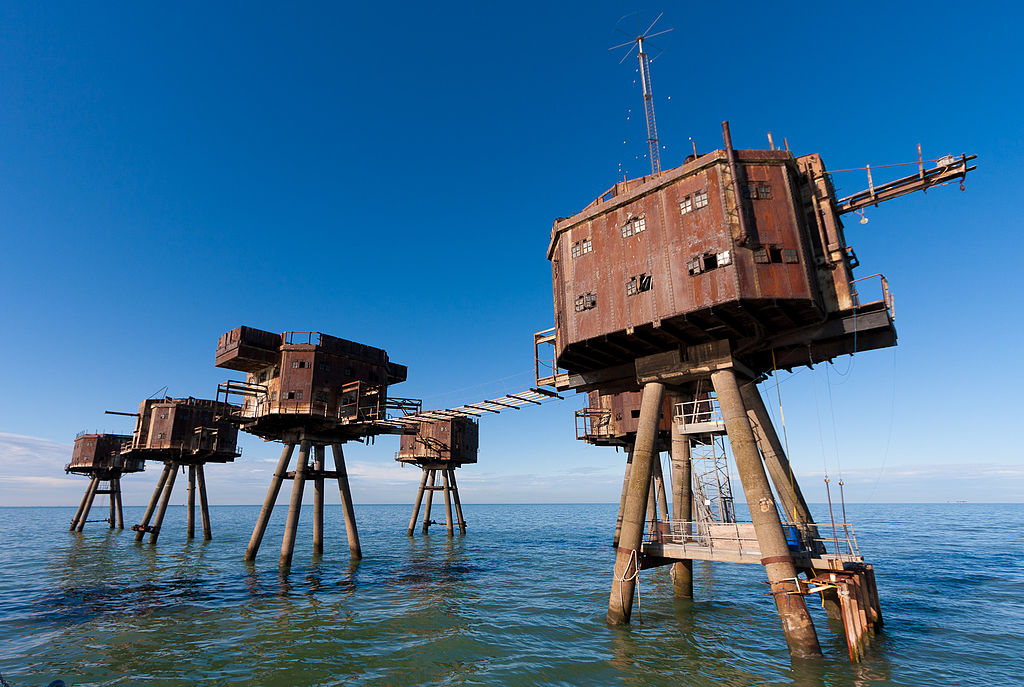“You may not be interested in war, but war is interested in you.” — Leo Tolstoy
After the 1919 Versailles Treaty ended World War I, there was an understandable push to prevent a major war from ever happening again. In hindsight, though, this Long Armistice was just a break from fighting before World War II, which in the United States’ case started with Japan’s bombing of Pearl Harbor, Hawaii in 1941. The conflict started earlier in Asia (1937) and Europe (1939). How did the armistice come unraveled? For one, the dedication to peace among most countries allowed aggressive ones like Japan and Germany to get away with more than they otherwise would have. That appeasement is a typical starting point in many interwar accounts. The non-aggressor nations also weren’t able to provide an effective international framework of their own between the wars. Britain led prior to World War I and the U.S. after World War II, but no one country stepped up between the wars to maintain stability.
Once the world economy started to crumble in the late 1920s, nations reverted to protectionism instead of reaffirming open trade agreements. The U.S. reinstated tariffs as global trade stalled, forcing American allies to rely on Germany repaying them their debt. As we saw in Chapter 8, the U.S., Britain, and Europe remained yoked together under tight monetary policy tied to the gold standard, inhibiting stimulus spending when the Depression set in. Congress passing the Smoot-Hawley Tariff in 1930 only made things worse.
In the United States’ case, that inward economic turn matched their diplomatic isolationism. Woodrow Wilson’s League of Nations never gained effective traction and didn’t grant itself the authority to intervene militarily or economically. The U.S. didn’t join the League even though its president, Woodrow Wilson, founded it (see cartoon, below). America’s League opponents weren’t mere reactionaries; they made a solid isolationist case that membership over-committed the U.S. to intervene all over the world in conflicts that didn’t really concern Americans. That being said, the American boycott weakened the League and helped prevent it from being able to counter Japan or Germany. As we’ll see, a multitude of factors was to blame for World War II and they unfolded in two distinct regions. Japanese and German militarization created two simultaneous threats in Asia and Europe. While the two theaters overlapped and influenced each other, we’ll divide our discussion of the run-up to WWII geographically.
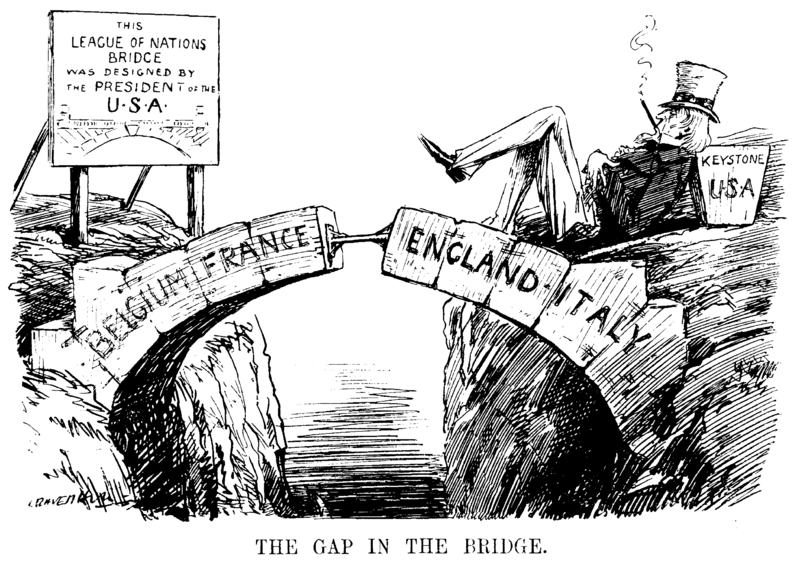
Gap in the Bridge (Cartoon About Absence of the USA From the League of Nations), Depicted as the Missing Keystone of the Arch, w. Cigar Symbolizing Uncle Sam Enjoying Wealth, Leonard Raven-Hill, Punch Magazine, 1919
WWII In Asia
In Asia, the U.S. and Britain were leery of Japan’s rapid industrial and military buildup. During WWI, the Japanese took advantage of Europe’s preoccupation and their alliance with Britain to expand their holdings in the Pacific, especially at the expense of Germany. At the Washington Naval Conference after the war, Japan agreed to freeze the proportion of their battleship tonnage in relation to Britain and the U.S. at a 3-5-5 ratio (unlike Japan, the U.S. and Britain had to maintain two-ocean navies). However, nobody anticipated the advent of aircraft carriers (aka flat-tops), which weren’t included in the agreement. Restrictions on traditional capital ships only motivated the U.S. and Japan to put more money and research into carriers. Likewise, the Versailles Treaty’s restrictions on traditional armaments only motivated Germany to research rocketry. The U.S. also started a special Air Corps within the Army that became the Army Air Force (USAAF) and branched off into the Air Force after World War II, and they trained pilots in the Navy/Marines. While planes didn’t have a huge impact on the outcome of WWI, they evolved to the point that everyone could see that future wars would be won or lost in the air. After WWI, the U.S. also scrapped over half its aging naval fleet and shrunk its standing army down to 136k.
Regardless of how many carriers or planes they built, Japan was slamming shut the Open Door Policy that had kept China’s spoils evenly divided amongst Japan and the West since the late 19th century. Just as the U.S. claimed all the Western Hemisphere as its sphere of influence starting in the 1820s, Japan now countered the American Monroe Doctrine and Roosevelt Corollary with the euphemistically-named Greater East Asia Co-Prosperity Sphere. Translation: Japan was taking over Asia. They were following the same logic Alfred T. Mahan had laid out for the U.S. in the 1890s in terms of acquiring overseas territories (markets) and building a strong navy to fuel domestic industry (Chapter 3). Mahan based his theories on Britain’s rise to maritime and naval prominence and the British model, not America’s, fit Japan best. Like England, Japan was a small island country and had even fewer natural resources (some coal), but they hoped to dominate the western Pacific economically with a superior navy. They conquered Okinawa and the remaining Ryukyu Islands in 1879 and they coveted raw materials on the Chinese mainland and in Russia’s far eastern territory.
Japanese fed themselves the usual gibberish about God liking them better than others. What else could explain their racial superiority over other Asians? In Japan’s case, Emperor Hirohito lent credence to their version of Manifest Destiny but its Parliament (National Diet) and generals, led by Hideki Tōjō (prime minister starting in 1941), pursued military expansion most aggressively. There was an internal debate about the government’s direction and militarists asserted greater control and took charge after the 7.9-magnitude Kantō Earthquake that destroyed Tokyo in 1923, killing over 140k. Touting order after the disaster, they kept communism and republicanism at bay, moving the country toward fascism. By the 1920s, Japanese schools were denigrating the Chinese. Religious chauvinism and racism provided ideological frosting on the cake, with the main goal being economic growth.
Unlike Europeans, Japanese weren’t haunted by memories of the Great War. They’d profited from WWI by acquiring German islands in the Versailles Treaty and their last major war was a happy memory: victory over Russia in the northwest Pacific in 1905. Now, the extension of Russia’s Trans-Siberian Railway to Vladivostok was threatening Japan’s potential control of Manchuria in northeastern China. But their expansion began earlier, closest to home in the Ryukyu Islands in 1879, that they renamed Okinawa. In 1895, Japan laid claim to the iron and coal-rich Korean Peninsula and Taiwan (then Formosa) in the First Sino-Japanese War against China’s Qing Dynasty. They annexed Korea in 1910. In 1931, hoping to offset the Depression, Japan took over Manchuria, a mineral and coal-rich area with good soil for soy and barley. Roundly condemned by foreign statesmen for this act of naked aggression, the Japanese walked out on the League of Nations, but the League didn’t act to stop their Manchurian invasion. Smaller skirmishes with China ensued from 1932-37 and, while the U.S. sold them oil, scrap metal, and steel, Japan conquered most of China in 1937 in the Second Sino-Japanese War, kicking off World War II in the Pacific with attacks on Peking (Beijing) and Shanghai.
Following the “Three Alls” motto, Japanese forces were instructed to “kill all, loot all, burn all” in a scorched-earth campaign. They raped, poisoned, and brutalized Chinese civilians on a massive scale, just as they soon would throughout Asia. At Nanjing, they slaughtered so many in six weeks that they faced logistical challenges dealing with the corpses and eventually had to force Chinese survivors to bury the body parts themselves or to walk into their own graves to be buried alive. The leader of Japan’s secret service in Shanghai said, “we can do anything to such creatures.”
Tragically, China inadvertently killed half a million of its own people when they opened the floodgates on the Yellow River in an attempt to stop the Japanese invasion. Fifteen million Chinese died in the eight-year war against Japan but they never capitulated. Japan eventually got bogged down in China, especially after Soviet troops defeated them in Outer Mongolia in the Battles of Khalkhyn Gol in 1939. If they hadn’t, they might not have looked to the southwest Pacific for oil in 1941, bringing them into conflict with the Americans and British, about which more later. Before Khalkhyn Gol, the army had preferred the northern approach whereas the navy coveted oil and rubber toward the south, including French Indochina (Vietnam) and the Dutch East Indies (Indonesia).
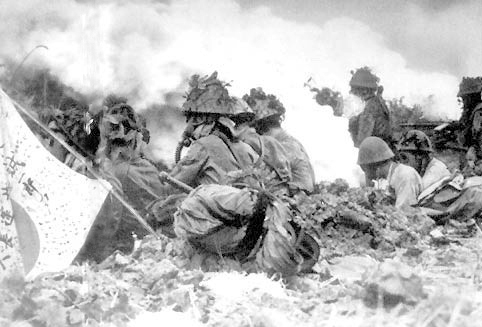
Chemical Warfare in the Sino-Japanese War, Hunan Front Near Changsha, 1941, Cabinet Printing Bureau of the Empire of Japan
The U.S. feigned some disapproval over the 1937 Japanese invasion of China but wasn’t put off enough to discontinue feeding the war machine. America was in a depression and needed the money. Japan then slowly encroached further and further across Asia, taking over French-held Indochina (Vietnam, Laos & Cambodia) in 1940. At that point, the U.S. was concerned for its own oil interests in Indonesia and cut Japan off from oil, scrap metal, and steel, demanding that they retreat out of Indochina. We’ll revisit Asia below after first examining Europe between the wars.
Weimar Germany
History is full of mistakes that leaders and nations would correct if only they could rewind the clock. The punitive treatment of Germany at the end of WWI is an obvious example — one we’ll see that the U.S. learned from and corrected after WWII. Of course, we don’t know for sure that Germany wouldn’t have caused problems for the rest of Europe even if they’d been dealt more generous terms at the Versailles Peace Conference. Drawing a simple, straight line from the Great War to Nazi Germany is overly deterministic, given that nearly fifteen years transpired in between. But martyrdom and vengeance fueled the Nazis’ rise. It’s impossible to understand Nazism without understanding the context of WWI. Instead of that bloodbath being the “war to end all wars,” as advertised, critics called its concluding Versailles Treaty the “peace to end all peace.”
While Germany’s invasion of Belgium in 1914 was rightfully condemned as worsening an already volatile situation, it was unfair that Germany was singled out and blamed for the Great War. Austria, for one, could’ve dealt with the Archduke’s assassination without punishing the entire Serbian population for the actions of the Black Hand terrorists (Serb army) and Britain could’ve stayed out altogether. As we saw in the Great War chapter, American diplomats inserted the so-called War Guilt Clause regarding Germany, despite President Woodrow Wilson’s initial promise of lenient terms. Others have argued that the clause mentioned no such thing and that Germans played up the guilt factor to elicit international sympathy. The text reads: “The Allied and Associated Governments affirm and Germany accepts the responsibility of Germany and her allies for causing all the loss and damage to which the Allied and Associated Governments and their nationals have been subjected as a consequence of the war imposed upon them by the aggression of Germany and her allies.”
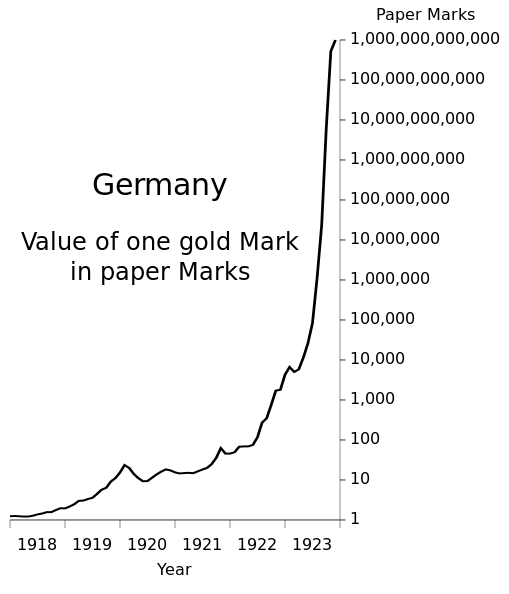
Between August and November 1923, a U.S. Dollar Went From Being Worth 630,000 Deutsche Mark to 630 Billion DM.
All the losers, not just Germany, got the blame. Either way, it was unrealistic, unfair and counterproductive to expect Germany to pay the victors’ debts. Kaiser Wilhelm had to abdicate his throne, they destroyed their submarines, planes, and battleships, and Germany gave up territory in the west to France and east to the reconstituted country of Poland along with overseas colonies in the Pacific and Africa. Adding insult to injury, the Allies embargoed Germany for another year-and-a-half, ostracizing them just when Western Allies should’ve been propping up the struggling democracy that ruled the country in the 1920s. The Weimar Republic (or Deutsches Reich), named after the city in Germany where the new constitution was written, practiced a form of government that Britain and the U.S. should’ve been supporting since they had a stake in displacing other options. Instead, the Weimar Republic struggled to get out from under the Versailles Treaty restrictions. They experienced hyperinflation in the early 1920s due to the German Mark’s devaluation (especially in relation to the British pound), recovered briefly, and then sank into a depression that exacerbated the worldwide 1930s slowdown.
When Germany fell behind on its payments from 1923-25, French and Belgian troops occupied the Ruhr Valley in northern Rhineland, Germany’s industrial heartland, demanding coal and steel to pay off their debt. Coal shortages triggered German inflation and Nazis filmed French soldiers kicking around Germans who failed to doff their caps and killing uncooperative miners and factory workers. The humiliation of the Ruhr Valley occupation played directly into Nazis’ hands as they recruited resentful Germans in nearby Bavaria.
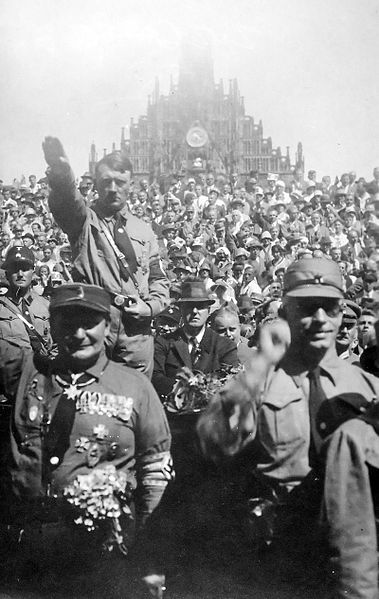
Hitler @ Nuremberg Rally, 1928, National Archives Collection of Foreign Records Seized, Heinrich Hoffman Collection
Germany’s erratic economy also played into Nazis’ hands. The U.S. restructured Germany’s debt under the 1924 Dawes Plan that staggered their payments, tied repayment to productivity in the German economy, and extended the reparation deadline. But Germany was still mainly borrowing from private U.S. lenders to pay off its debt to the U.S. government. Dawes also called for the withdrawal of Allied troops from the Ruhr Valley. That temporarily resolved Germany’s economic crisis and led to a brief rebound. However, the U.S. wouldn’t forgive Britain or France their debts, so those countries needed Germany’s full payments to repay America. Ultimately, the U.S. lent to Germany and the reparations just cycled back to the U.S. via Britain and France. Germany’s economy was tethered to Western countries as they experienced their own downturns. The American Dawes Plan gave way to the 1929 Young Plan, that reduced the amount owed by 20% down to 122 billion Gold Marks (around $8 billion 1929 dollars or ~ $100 billion today), with the final installment due in 1988. These measures didn’t suffice, especially after the American Stock Market Crash and Smoot-Hawley Tariff contributed to a worldwide slowdown. President Herbert Hoover declared a one-year moratorium on German debt in 1931 but that didn’t help much, either. Adding fuel to the fire — in a precursor to the Credit Default Swaps that got the world in trouble in 2008 — by 1931, Britain’s top investment banks had sold credit guarantees to investors in German debt. When Germany defaulted the British government went from surplus to debt as they bailed out their financial sector.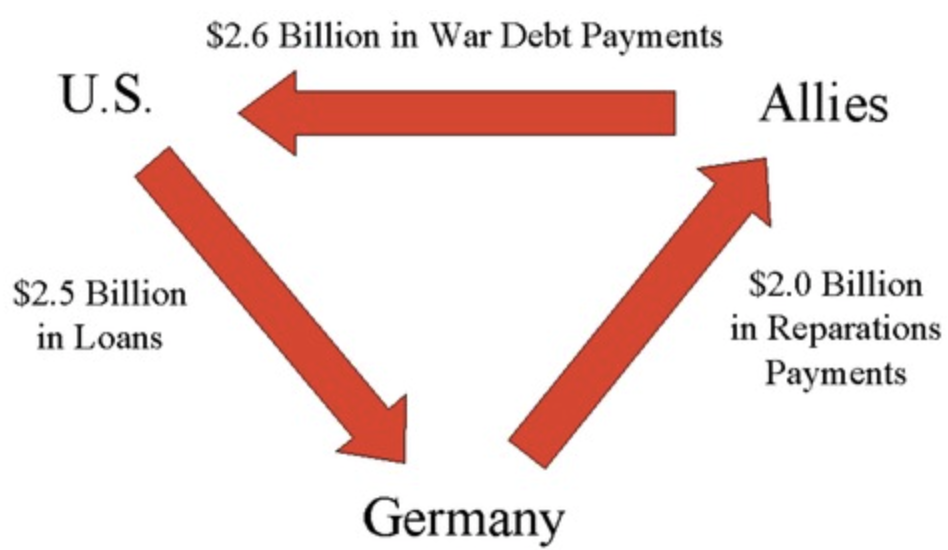
The Weimar Republic had political problems as well. Its constitution muddled the relationship between the chancellors, presidents, and Reichstag (Parliament). It allowed leaders to rule without Parliament’s consent in an emergency but didn’t clearly define emergency. Germany had a multi-party democracy, with each party winning seats in the Reichstag proportional to their percentage of votes. The center didn’t hold under World War I general and 1920s President Paul von Hindenburg. In the 1928 elections, the Nazis won less than 3% of votes, but WWI flying ace Hermann Göring (Gestapo founder and Luftwaffe head) and Joseph Goebbels (Nazi Propaganda Minister) won seats, and Goebbels later said they entered Parliament like “wolves into the sheep’s pen.” Democracy offers a portal through which fascism can enter insofar as true political freedom allows for extremism and free speech allows for disinformation. Goebbels gloated, “this will always be one of the best jokes of democracy — that it gave its deadliest enemies the means by which it was destroyed.”
Rise of Nazis
Like all European countries where monarchies fell at the end of WWI, Germany was volatile afterward as factions competed to fill the vacuum. The three main options were democratic capitalism (republicanism, classical liberalism), communism, and fascism — a jingoistic form of dictatorship that compels allegiance to a militaristic state, including by corporations. Fascism promotes order, racial superiority, and militarism. Fascism includes a cult of personality around a particular leader who advertises himself as the sole solution to a nation’s problems, encourages violence among followers toward scapegoats, undermines trust in liberal institutions like elections, courts, and free press, lies incessantly while accusing others of lying (to the point his followers no longer recognize truth), employs racism and victimization in grievance politics (often with promises of vendettas), and sees himself as above the law. Historian Robert Paxton offers this definition:
Fascism may be defined as a form of political behavior marked by obsessive preoccupation with community decline, humiliation, or victimhood and by compensatory cults of unity, energy, and purity, in which a mass-based party of committed nationalist militants, working in uneasy but effective collaboration with traditional elites, abandons democratic liberties and pursues with redemptive violence and without ethical or legal restraints goals of internal cleansing and external expansion.
Since fascism promises to get rid of democracy’s inefficiency, argumentation, and messiness, it’s appealing to countries undergoing the sort of trauma Germany was suffering in the late 1920s and early ’30s. Neighboring Italy also struggled after WWI. Its dictator, Benito Mussolini, defined fascism as “the state which educates its citizens in civic virtue, gives them a consciousness of their mission, and welds them into unity.” Mussolini manufactured chaos than capitalized by offering stability. Violence and disorder from his own street militias convinced King Victor Emanuele III to deny aid to Prime Minister Luigi Facta and appoint Mussolini after Facta resigned. 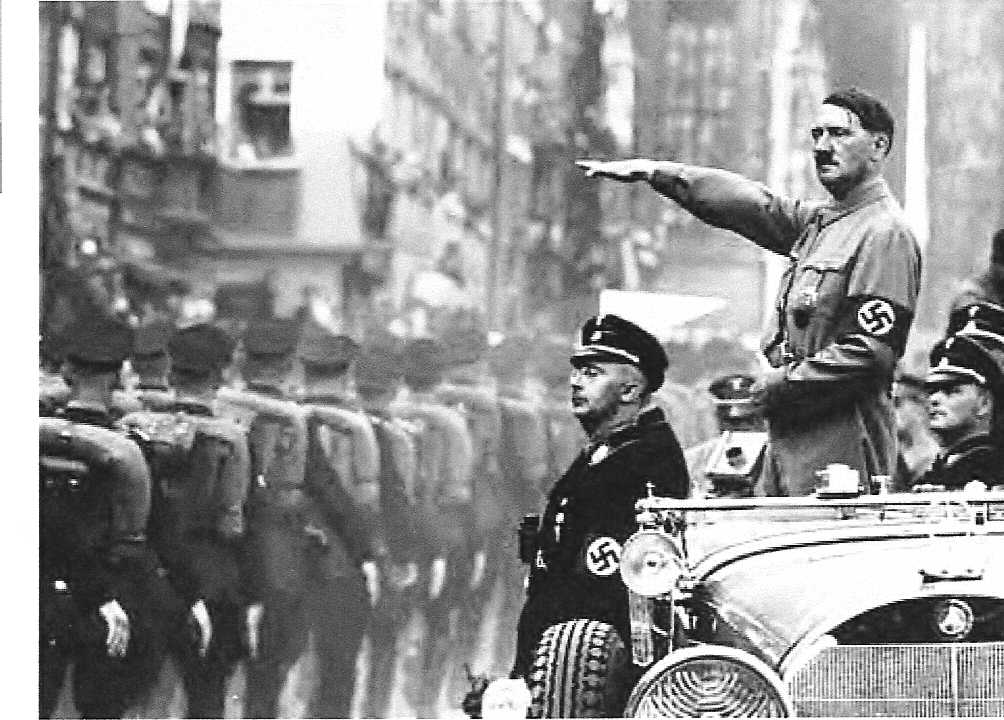
Adolf Hitler’s paramilitary group, the Nazis, was one group promoting fascism in Germany. Economically, the Nazis didn’t fit easily into the traditional right-left spectrum. Their full name was the National Socialist German Workers Party, implying a left-leaning stance, but Nazis hated communists and considered them their arch enemies along with Jews (the term Nazi predates this era, referring to backward farmers, and was first applied by opponents). The dislike between communists and Nazis was mutual as early as 1929, indicated by a scene from the classic silent documentary Man with a Movie Camera, in which a young Soviet woman takes aim at a Swastika in a carnival shooting gallery. After WWI, Hitler was an army spy who ferreted out communists. On the other hand, Nazis claimed at first to hate the crassness of capitalism and the red in their flag represented a peoples’ movement; they were populists who appealed to the masses. Their early platforms included pension funds for senior citizens. And Lenin’s totalitarianism no doubt influenced Hitler and Mussolini. One complication for Hitler economically was that his special army of street thugs, the Brownshirts (or Sturmabteilung aka SA), were anti-capitalist, but industrialists like steel magnate Fritz Thyssen and Henry Ford eventually bankrolled the Nazis’ rise to power, along with gold confiscated from Jewish bankers. When that tension became irreconcilable by 1934, Hitler had the SS murder left-wing factions (Strasserists) and Brownshirt/SA leaders on the Night of the Long Knives and the capitalists took control. Industrial monopolies in steel, rubber, and coal supported Hitler and helped bring him to power. In Italy, Mussolini described fascism as a “merger between state and corporate power.” The Night of the Long Knives marked the ascendance of the SS over the SA and commenced the systematic castration and imprisonment of homosexuals.
Hitler had fought for Germany rather than his native Austria in WWI because of his admiration for Germany. He reinvented himself there after his rejection to art school resulted in him living like a bum on Vienna’s streets prior to the war. Corporal Hitler loved the trenches and sanctioned killing of the Great War, in which he won the Iron Cross for his dangerous work as a courier. Like some others in the military, he despised the “November criminals” who capitulated to the Allies in the armistice that ended the war. The Nazis’ stab-in-the-back myth, or Dolchstoßlegende — an extreme example of grievance politics — blamed a cabal of Marxists, Jews, and republicans for overthrowing the Hohenzollern monarchy at the end of WWI, giving up the fight even though Germany wasn’t defeated. This distorted legend underestimated the extreme pressure Germany’s military and economy were actually under by the fall of 1918. The German Revolution of 1918-19 did replace the monarchy with the Weimar Republic, but Germany gave up for a reason.
Hitler interpreted his numerous escapes during WWI as a sign that God had singled him out for the divine mission of running Germany. He was convalescing from a mustard gas attack when the war ended and may have suffered a groin injury at the Battle of the Somme in 1916. He often recounted his miraculous recovery at a Berlin hospital, when he regained his sight and had a vision of Jews stabbing the German eagle. As specialists in hate, there was plenty more room under the Nazi tent for others besides Jews and communists, including Gypsies (Romani), Jehovah’s Witnesses, homosexuals, and disabled, all of whom they wanted exterminated.
Hitler and a band of former generals, including Erich Ludendorff, tried but failed to take over Munich in 1923 in the Beer Hall Putsch, after which Hitler was arrested. His eloquent and passionate trial defense increased his notoriety, though. He won over a portion of the jury and, rather than being executed, he got five years in comfortable house arrest. There, he dictated Mein Kampf, or My Struggle, to editor Rudolph Hess, condemning the Versailles settlement and blaming Germany’s small Jewish population for problems in banking and their potential to bring about communism (Lenin was ¼ Jewish). Banking and communism aren’t generally grouped together for obvious reasons but, in Hitler’s mind, both were at fault. Jews had controlled much of Germany’s gold, but mainly because it was illegal for them to hold currency. As mentioned, Nazis confiscated much of it, using it to finance their military. Swiss banks laundered stamped Jewish bullion for the Nazis.
Mein Kampf didn’t sell well at first, as Hitler was mostly forgotten in the mid-1920s because fascist groups were still marginal. After the Stock Market Crash of 1929 worsened Germany’s economy, Hitler’s message of order and violence resonated among a critical balance of those suffering from hunger and inflation and they intimidated many others. He made it compulsory reading after he seized power in 1933 and the royalties made him rich. Hitler wrote in Mein Kampf, “Only the application of brute force used continuously and ruthlessly can bring about the decision in favor of the side it supports.”
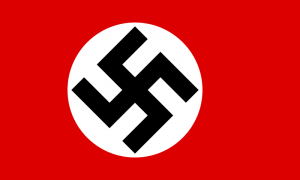 The Nazis’ popularity rose to ~ 20% after the Stock Market Crash in 1929. By the early 1930s, the chancellors (appointed by the president) were overriding the Reichstag, culminating in Chancellor Hitler. No one party was able to establish clear rule and the far left and far right challenged the Republic’s existence upheld by centrists: Social Democrats (SPD) and the Catholic Center Party, or Zentrum. Nazis won ~ 37% of votes in the 1932 election. Hindenburg, an independent, temporarily dissolved Parliament and named Hitler chancellor in 1933 despite initially opposing him. While Nazis entered power via democracy, the actual naming of Hitler as chancellor resulted from a backroom deal as Germany’s economy went into a tailspin in early 1933, not an actual election. Nazi Storm Troopers fought communists in the streets prior to the 1932 elections while Hitler campaigned tirelessly, averaging five speeches a day. By then, Nazis constituted a plurality in the Reichstag if not an actual majority, polling especially well in cities and among rural Protestants in the north. Meanwhile, Hitler dismissed media critical of him as luginpresse, or “lying press.” In short, Nazis came to power through a combination of democratic elections, media manipulation/propaganda, warped history, and street-level intimidation. Hitler still seemed like a marginal nutcase to most by 1928 when Germany’s economy was on the mend, but after the 1929 Crash left six million unemployed (24%) the public yearned for order amidst the chaos. Order was the Nazis’ specialty, or at least their promise.
The Nazis’ popularity rose to ~ 20% after the Stock Market Crash in 1929. By the early 1930s, the chancellors (appointed by the president) were overriding the Reichstag, culminating in Chancellor Hitler. No one party was able to establish clear rule and the far left and far right challenged the Republic’s existence upheld by centrists: Social Democrats (SPD) and the Catholic Center Party, or Zentrum. Nazis won ~ 37% of votes in the 1932 election. Hindenburg, an independent, temporarily dissolved Parliament and named Hitler chancellor in 1933 despite initially opposing him. While Nazis entered power via democracy, the actual naming of Hitler as chancellor resulted from a backroom deal as Germany’s economy went into a tailspin in early 1933, not an actual election. Nazi Storm Troopers fought communists in the streets prior to the 1932 elections while Hitler campaigned tirelessly, averaging five speeches a day. By then, Nazis constituted a plurality in the Reichstag if not an actual majority, polling especially well in cities and among rural Protestants in the north. Meanwhile, Hitler dismissed media critical of him as luginpresse, or “lying press.” In short, Nazis came to power through a combination of democratic elections, media manipulation/propaganda, warped history, and street-level intimidation. Hitler still seemed like a marginal nutcase to most by 1928 when Germany’s economy was on the mend, but after the 1929 Crash left six million unemployed (24%) the public yearned for order amidst the chaos. Order was the Nazis’ specialty, or at least their promise.
After Nazis claimed victory in disputed 1933 elections, they set about dismantling the democracy that had brought them to power. In the euphemistically titled Law to Remedy the Distress of the People, or Enabling Bill, they outlawed future elections. The Burning of the Reichstag (Parliament building) was the key pretext for Nazis suspending republicanism (voting and civil liberties) and eradicating communists at the same time, killing two birds with one stone. They blamed a Dutch communist for the fire and beheaded him while non-Nazis (and most historians) suspected the Nazis themselves of arson in a false-flag operation. To this day, the term Reichstag Fire signifies a power grab whereby leaders manufacture a crisis or exploit a real one to blame opponents, distract citizens, or convince citizens to surrender liberties (e.g., the Japanese far-right exploited the 1923 earthquake, even though they didn’t manufacture that crisis, and Hungary’s Viktor Orbán did likewise in his “Coronavirus Coup”). Nazis won more parliamentary elections shortly thereafter, giving them an outright majority rather than a mere plurality, but any semblance of democracy evaporated. Hitler said, “There will be no mercy now. Anyone standing in the way will be cut down.” Nazis thereafter arrested and detained people without pressing charges or allowing them to stand trial and passed the Enabling Bill that, based on a perpetual post-Reichstag “state of emergency,” transitioned Germany into a dictatorship. With the peoples’ support (some polls suggested ~ 90%, though it was risky to voice opposition) Hitler conflated the offices of chancellor and president into Der Führer (leader). Most of those opposed moved west to the Saar, then controlled by France but soon reconquered by Germany.
The Reichstag fire and response intimidated and/or brought on board many middle-class Germans otherwise skeptical of the new regime. Nazis ostracized centrists/republicans (i.e., Social Democrats and Center Catholic Party) as “socio-traitors” for not going along with book burnings, harassments, and heavy-handed tactics. In the Berlin suburb of Köpenick, Sturmabteilung (SA) rounded up hundreds and tortured to death 91 resistant Jews, Social Democrats, communists, and Catholics in the “Week of Bloodshed,” throwing their corpses in the river. Nazis beat prisoners until their kidneys exploded and poured hot tar in open wounds. As one German put it in 1933, “Every day the opposition is tortured with whips and electric drills. Better to celebrate and howl with the wolves.” Those that refused to raise their hand and Heil Hitler (salute) were sent off to the camps with the others.
First they came for the Socialists, and I did not speak out–
Because I was not a Socialist.
Then they came for the Trade Unionists, and I did not speak out–
Because I was not a Trade Unionist.
Then they came for the Jews, and I did not speak out–
Because I was not a Jew.
Then they came for me–and there was no one left to speak for me.
— Martin Niemöller, German Protestant Pastor
Rebuilding Germany
Politically, Nazis despised the disorganized ineptitude of democracies, with their respect for debate and free speech. Fascists could claim that their dictatorships got things done, most famously expressed in the phrase trains ran on time. Hitler implemented a more aggressive Keynesian strategy of stimulus spending than his contemporary Franklin Roosevelt, rebuilding the country and putting people back to work. Relative to GDP, Germany spent about 5x more than the New Dealers and it worked. The Nazis pioneered interstate engineering (four-lane roads, on-ramps/exits, overpasses) in their Autobahn, that they hoped could move their military around the country more efficiently than dirt roads had during WWI. The project actually began under the Weimar Republic but had floundered.
Hitler not only admired Henry Ford’s anti-Semitism, but also the industrial efficiency of his plants, and hoped to jumpstart Germany’s economy with their own car for the common folk, the Volkswagen. Hitler suggested the aerodynamic “beetle” shape to its designer, Ferdinand Porsche, who shared the dream of a car for the people. They invited Ford to Germany and awarded the industrialist the Grand Cross of the German Eagle on his 75th birthday.
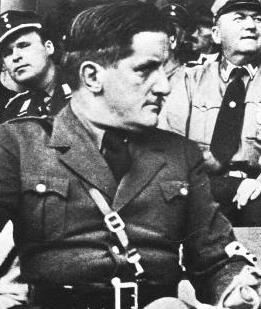 Nazis reveled in the country’s economic rebound and patriotic resurgence. They excelled at pageantry, hosting orchestrated public festivals where Germans camped out and celebrated their culture. In huge stadiums, they heard inspiring speeches and showed their allegiance in choreographed, well-documented spectacles. Hugo Boss designed sharp uniforms for the SS and Hitler Youth. Nazis indoctrinated youth and Hitler said that he hoped to see, again, in their eyes “the gleam of the beast of prey.” Hitler Youth and Brownshirts marched to songs adapted from Harvard’s fight song, written by Hitler’s friend and Harvard alum Ernst Hanfstaengl (right). They held Nazi Party Rallies in Nuremberg (Nürnberg) from 1923-1938. Hitler loved film and was at least as adept on the radio as FDR. He took acting lessons and began to excel after the invention of sound film. He studied dramatic gestures in opera and cultivated a domineering persona to better manipulate the masses, of which he said, “they’re feminine and stupid…only emotion and hatred can keep them under control.” Charlie Chaplin called Hitler the best actor he’d ever seen.
Nazis reveled in the country’s economic rebound and patriotic resurgence. They excelled at pageantry, hosting orchestrated public festivals where Germans camped out and celebrated their culture. In huge stadiums, they heard inspiring speeches and showed their allegiance in choreographed, well-documented spectacles. Hugo Boss designed sharp uniforms for the SS and Hitler Youth. Nazis indoctrinated youth and Hitler said that he hoped to see, again, in their eyes “the gleam of the beast of prey.” Hitler Youth and Brownshirts marched to songs adapted from Harvard’s fight song, written by Hitler’s friend and Harvard alum Ernst Hanfstaengl (right). They held Nazi Party Rallies in Nuremberg (Nürnberg) from 1923-1938. Hitler loved film and was at least as adept on the radio as FDR. He took acting lessons and began to excel after the invention of sound film. He studied dramatic gestures in opera and cultivated a domineering persona to better manipulate the masses, of which he said, “they’re feminine and stupid…only emotion and hatred can keep them under control.” Charlie Chaplin called Hitler the best actor he’d ever seen.
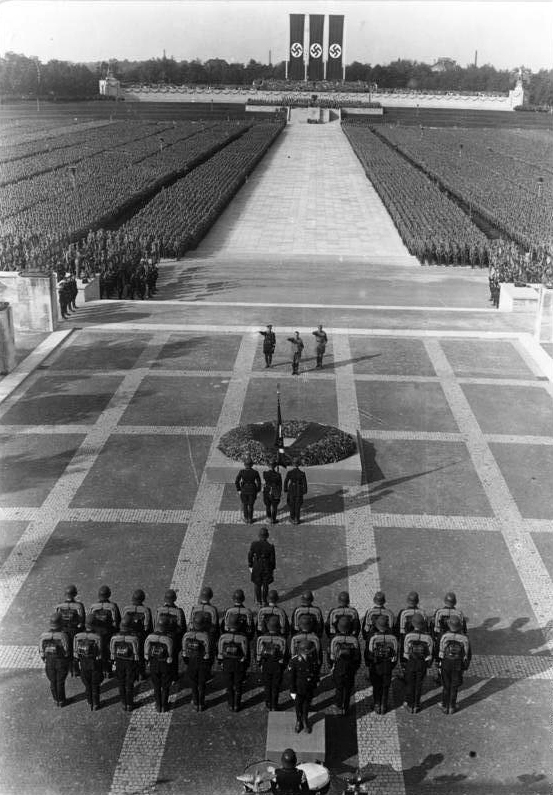
The Totenehrung (honoring of the fallen) at the 1934 Nuremberg Rally. SS leader Heinrich Himmler, Adolf Hitler and SA leader Viktor Lutze (from L to R) on the stone terrace in front of the Ehrenhalle (Hall of Honor) in the Luitpoldarena. In the background is the crescent-shaped Ehrentribüne (the Tribune of Honor).
Germany started a breeding program between single women and Nazi officers called Lebensborn to propagate their new super race. Their political agenda started off innocuously in comparison with what came later: instituting prayer in public schools, loosening up gun laws (except for Jews), banning homosexuality, revoking Jewish citizenship, and banning intermarriage between Jews and Gentiles (non-Jews) with the Nuremberg Laws. German Jews were then Jews in Germany, but not Germans. Heinrich Himmler was the main architect of the Final Solution, or what Hitler called “the final solution to the Jewish question:” extermination. Himmler led the top-secret police/paramilitary rung, the Schutzstaffle, or SS.
The first concentration camps opened in 1933 but were mostly kept under wraps. Nazis were thuggish relative to most governments but stayed within the mainstream enough to curry cautious acceptance among fellow Europeans. Jews seemed no worse off legally than minorities in many countries as long as one didn’t know about the camps. Winston Churchill of Great Britain, for instance, appreciated Nazis as a bulwark against Soviet communism; and they were preventing the sort of Bolshevik revolution that happened in Russia in 1917. Nazis salvaged their reputation by curbing inflation and turning around the German economy. When the German Hindenburg airship blew up docking in New Jersey in 1937, Franklin Roosevelt sent Hitler a condolence note from his fishing boat off the Texas coast. The gigantic and infamous Zeppelin (4x larger than the Goodyear blimp) had symbolized Nazi strength at events like the Nuremberg rallies and 1936 Olympics.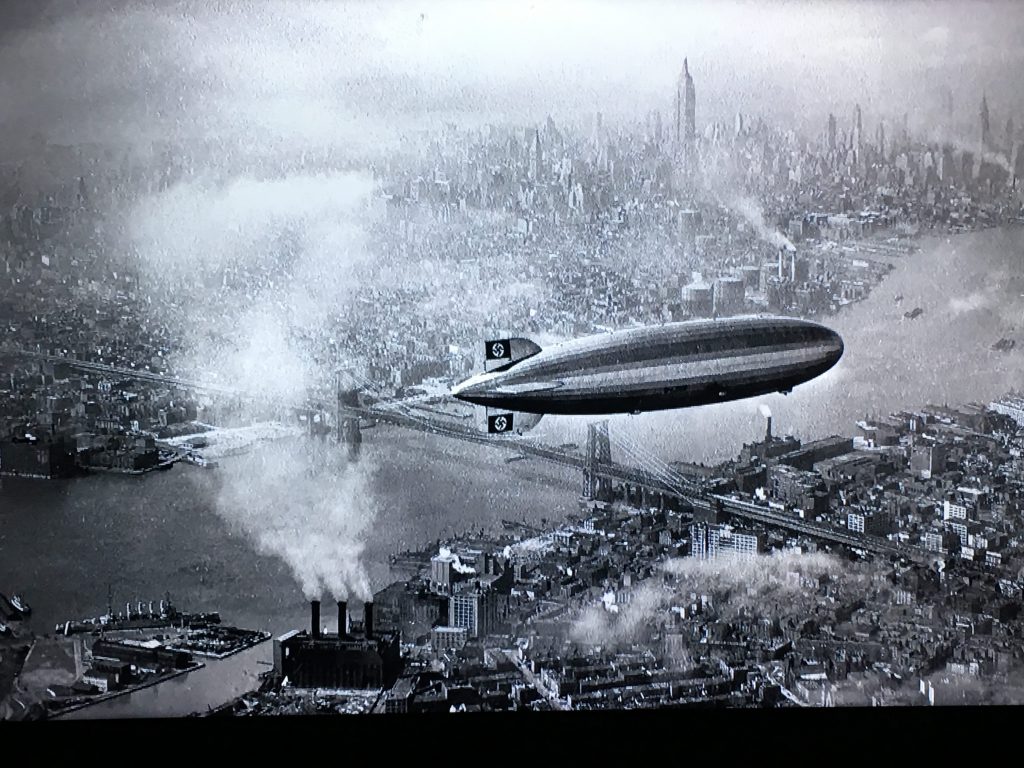
1936 Berlin Olympics
Germany showcased its rebuilt country in the 1936 Olympics. The mere fact that Berlin was chosen for the games signaled their readmission into the international community and tacit approval of fascism. Nazis took full advantage by building the first substantial Olympic village, temporarily taking down anti-Semitic billboards, clearing out Gypsies (Romani), outlawing prostitution, and treating foreign journalists and athletes hospitably. Visitors were oblivious to construction of the Sachsenhausen concentration camp north of Berlin. The sports complex was magnificent by 1930s standards and the same Hindenburg balloon that crashed in New Jersey a year later flew over the main stadium during opening ceremonies. Nazis underscored their connection with the ancient Greek Olympic founders by relaying the torch from Athens to Berlin — a tradition that lives on. Some International Olympic Committee (IOC) members thought Germany was a good choice to host the games because they embraced eugenics, similar to the ancient Greek Spartans’ killing of deformed babies.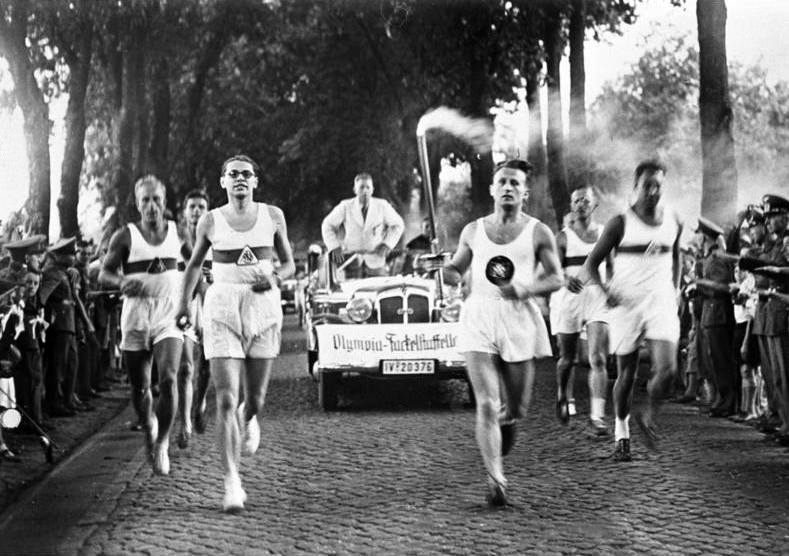
Hitler hoped to use the Olympics to prove the superiority of fascist regimes and largely succeeded. Germany, Italy, and Japan did well. Germany finished first in the overall medal count with the U.S. second, and American Olympic Committee president Avery Brundage argued that the U.S. should consider that as a lesson on the upside of fascism. Shortly after those comments, and likely because of them, Brundage became IOC president. But fascists didn’t win every event: African-American Jesse Owens (left) famously humiliated Hitler by winning four gold medals in track & field. The record-breaking sprinter from Ohio St. upset Hitler’s notion of Aryan superiority in front of a packed house and early television cameras. On a promotional tour across Europe after the Games, Owens quit and went home because, with no stipend, he was tired of sleeping in airplane hangers and begging for food. Brundage consequently stripped him of his amateur status and he had to rely on gimmick races against horses and trains. He got a victory celebration at New York’s Waldorf-Astoria Hotel but, as an African American, had to take the freight elevator to attend. Since FDR refused to meet with any black athletes, Owens said: “Hitler didn’t snub me — it was [Roosevelt] who snubbed me.”
The Olympics bought Hitler time and helped camouflage the Nazis’ real intentions, though the IOC awarded Germany the Winter Olympics in 1940 even after news of the Holocaust had leaked out (those Games were eventually canceled). Documentarian Leni Riefenstahl chronicled the 1936 Olympics and the 1934 Nuremberg Rally in Triumph of the Will. These aesthetically sophisticated films are must-sees for any student interested in propaganda or how the Nazis won over Germans in the 1930s. Riefenstahl was a great filmmaker despite her friendship with Hitler, having pioneered documentaries in the same way that German roadbuilders pioneered freeways.
Expansion
The Versailles agreement barred Germany from maintaining anything but a skeletal defense and most European powers, including Germany, pledged peace and promises of arbitration in disputes to one another in the Locarno Treaties of 1925. But France and the USSR signed a mutual pact in 1935 (similar to 1892), outraging Germany, and Germany was openly violating terms of the Versailles and Locarno treaties by the mid-1930s. Their economic revival wasn’t just based on highways, but also munitions. They made their first expansionary move in March 1936, retaking the Rhineland region ceded to France after WWI. That included the industrially important Ruhr Valley (the Ruhr is a Rhine River tributary).
Hitler actually instructed his troops to turn back if the French challenged them, but no such opposition materialized. Regions like the Saarland voted to rejoin Germany, despite the fact that the French-held areas were refugees for Nazi opponents. The Saarland vote surprised France. Germany claimed the Rhineland takeover was a justified response to the treaty France signed with the USSR, and the Versailles Treaty indeed called for a referendum there after fifteen years.
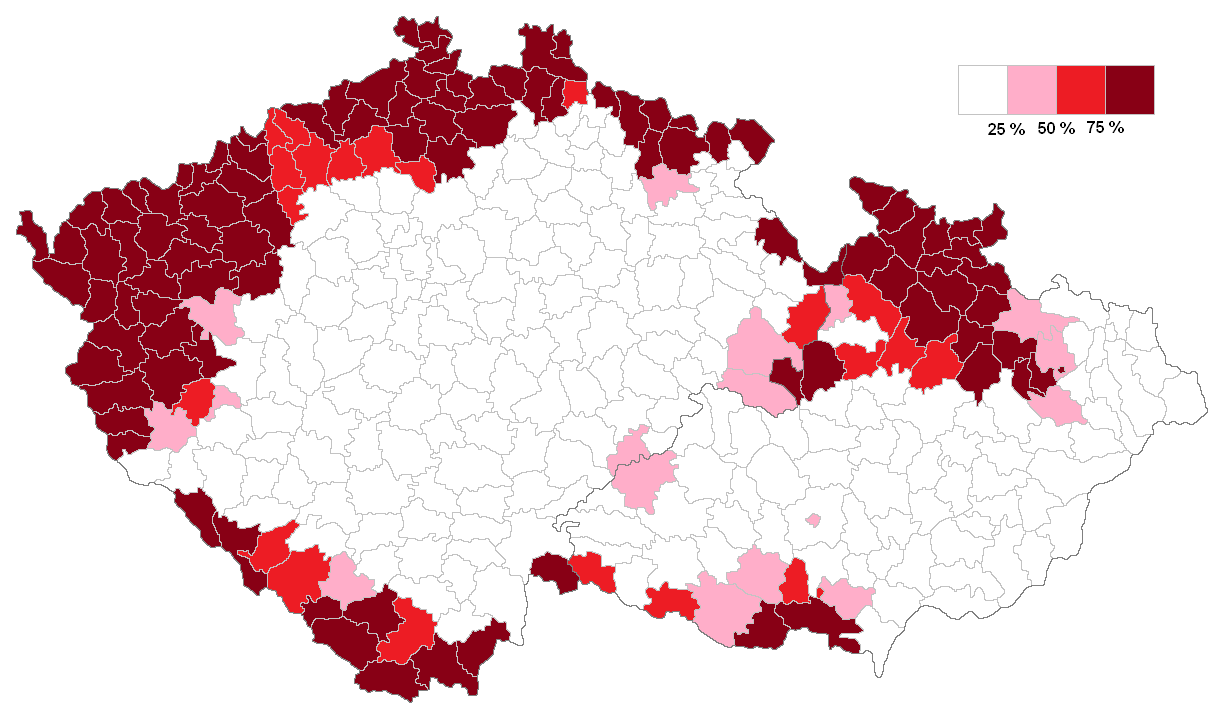
Czech districts with an ethnic German population in 1934 of 25% or more (pink), 50% or more (red), and 75 % or more (dark red) in 1935
Their next move was Hitler’s home country, where Austrian Nazis helped expedite a mostly bloodless takeover called the Anschluss in March 1938. Then, in October 1938, they made demands on the German-speaking Sudetenland of Czechoslovakia, a country created from scratch at Versailles. The Nazis had sympathizers and collaborators in virtually every European country. Most Austrians supported becoming part of Grossdeutschland (Greater Germany). Oswald Mosley was the leading fascist in England. Among the majority of Brits that opposed Mosley, Hitler took advantage of their desire for peace, knowing that he could get away with more than he would have had they not been haunted by WWI. And he took advantage of widespread anti-Semitism throughout the Western world. When WWII broke out, only Denmark, among occupied countries, refused to cooperate with their arrest, instead smuggling Jews in fishing boats to neutral Sweden.
Like every country on the make, Germany was only “defending itself” and its acquisition or reacquisition of German-speaking territory gave that narrative a shred of truth early on. The word for Germany’s army, the Wehrmacht, translates to defense force. The title of this 1928 map of territory lost in the Versailles agreement translates to “Germany’s mutilation:”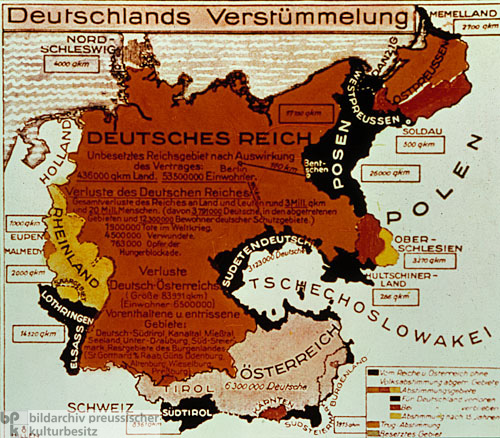
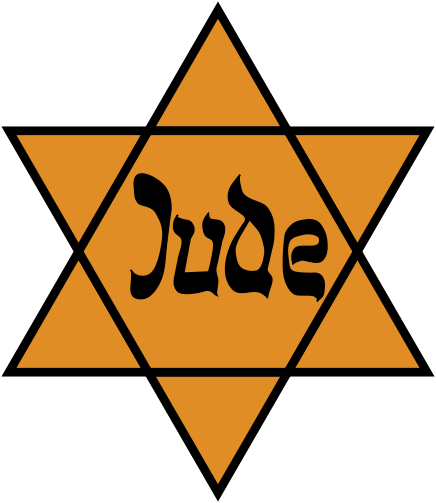 Anti-Semitism Worsens
Anti-Semitism Worsens
The German Jewish population only slowly lost faith in the idea that Germans and Western Europeans were too sophisticated and progressive to go for the type of rampant anti-Semitism more associated with Eastern Europe. Aside from being de-emancipated by the Nuremberg Laws, they were forced to wear yellow Star of Davids. On Kristallnacht, the “night of the broken glass” in 1938, Hitler’s paramilitary troops pillaged Jewish businesses and synagogues throughout Germany and Austria, killing hundreds as they rounded up 30k Jews to be sent off to concentration camps. They blamed Jews for the damage since they’d been the targets, fined them, and required that all the insurance money go to the state. The pretext for the attacks was the assassination of a German official in Paris by a Jewish teenager from Poland. FDR ordered American Ambassador Hugh Wilson home after the Kristallnacht. Wilson supported Hitler and broke with his predecessor William Dodd’s (1933-37) policy by attending a Nuremberg Rally. Wilson complained that “Jewish-controlled” critics back home sang “hymns of hate while efforts are made over here to build a better future.” For more on American corporate funding and ideological support for Nazi eugenics, see the optional section at the bottom of the chapter on Nazi ideology (anti-Semitism, religion, science, history, philosophy).
The German Weapons Act of 1938 loosened up gun restrictions, deregulating rifles and shotguns altogether for Gentiles while banning Jewish ownership, manufacture or dealing of firearms. Modern American enthusiasts inclined to liken gun registration to Nazism have their history mostly backward. While it would still be an irrelevant and bad analogy, a better comparison would be to liken gun control advocates to the Weimar Republic, since they toughened gun laws from 1919-32 in an effort to tame the sort of paramilitary groups Hitler led. Those were the laws the Nazis repealed in time for Gentiles to use guns on Jews during the Kristallnacht. Previously Nazis tightened up registration laws for social democrats, another potential enemy they didn’t want armed. What’s not backward about modern gun enthusiasts’ interpretation is that the Nazis took advantage of gun registrations to confiscate Jewish guns, though it’s worth pointing out that in the vast majority of historical cases registration hasn’t led to confiscation. However, having guns wouldn’t have helped Jews much as they were vastly outnumbered.
Many Jews (~ 25%) migrated when they could up through 1938, when immigration quotas even went unfilled. Shanghai offered an unlikely refuge for 17k refugees from Germany and Austria. The International Settlement within the Chinese city that the British, French, Americans, Italians, and Portuguese carved out in the nineteenth century (Chapter 3) included small populations of Sephardic Jewish traders from Iraq and Ashkenazi Jews who fled Russia during the Bolshevik Revolution in 1917 (Holocaust Museum). When Japan conquered Shanghai in 1937, they didn’t establish a naturalization policy, leaving a loophole whereby refugees could move there and the existing Jewish population helped them assimilate.
However, Western countries tightened their immigration restrictions once the going got rough in Germany. Some Jews had escaped to England earlier and later aided the Allies in translating bugged conversations of German POWs. In the U.S., Jewish refugee Albert Einstein helped convince FDR to develop the atomic bomb. (Other notable Jewish immigrants in the 1930s included future diplomat Henry Kissinger and founders of the influential Blue Note Record label.) But by 1938, Jews could still leave Germany with an exit tax and no one would take them, at least not in large numbers. Polls showed that most Americans disapproved of Nazi policies, but less than 20% of the “Greatest Generation” favored opening American shores to Jewish immigrant refugees. Eighty-five percent of Protestants and Catholics opposed offering Jews refuge, as did 25% of Jewish Americans. We should remember, at least, that few people knew about the concentration camps in the late 1930s.
Despite his own anti-Semitism (see optional article below), Franklin Roosevelt organized a conference at Evian, France to discuss the escalating Jewish refugee situation. Of the 32 countries participating in the Evian Conference, all expressed sympathy for the Jewish plight, just not quite enough to offer refuge. Only the Dominican Republic agreed to significantly loosen its immigration restrictions. Australian delegate Sir Thomas White typified the others’ attitude — and echoed Hitler’s justification for the Holocaust — stating that “Australia didn’t have a racial problem and we’re not desirous of importing one.”
It wasn’t easy for Gentiles to enter America for that matter since authorities feared Nazi sympathizers coming to spy or cause damage as Germans had during WWI. The family of Captain Georg Johannes (Baron) Von Trapp — subject of The Sound of Music (1964) — was detained at Ellis Island and nearly deported back to Europe, where they probably would’ve been arrested and liquidated by the Nazis. An Austrian naval commander decorated for service at the Boxer Rebellion and in WWI, Baron von Trapp (left) refused to fly the Swastika at their estate and then refused an invitation for his family to sing at Hitler’s birthday party. They fled Europe and headed for America with traveler’s visas (their 2nd trip there), but his wife Maria accidentally told the customs agent that they hoped to stay. Luckily, a family friend vouched for them and the Trapp Family Singers settled in Vermont and began touring the country.
Most Jewish immigrants were less fortunate. Defying First Lady Eleanor Roosevelt’s wishes, Franklin refused to loosen immigration laws once large numbers of refugees tried to escape in the late 1930s. The U.S. and Cuba turned away the MS St. Louis with nearly 1k Jewish refugees on board in 1939, though the passengers aboard the “voyage of the damned” eventually gained asylum in England, Belgium, and the Netherlands. Allowing the passengers entry into the U.S. would’ve violated the immigration quotas set in the 1920s. The U.S. allowed a total of ~ 211k Jewish immigrants from 1939-46. FDR purportedly complained about having to listen to Jewish sob stories about the plight of refugees (HNN). His Asst. Secretary of State, Breckenridge Long, was also anti-Semitic and, crucially, in charge of dispensing visas.
Nazis relished the harshness of Anglo-American immigration policy. One German diplomat gloated, “Since in many countries it was recently regarded as wholly incomprehensible why Germany did not want to preserve in its population an element like the Jews…it appears outstanding that countries seem in no way anxious to make use of those elements themselves now that the opportunity offers.” The tightening up of foreign borders in the late ’30s helped seal the fate of Jews trapped in Europe. Cartoonist Theodor Geisel, aka Dr. Seuss, captured the prevailing sentiment of most Americans regarding refugees circa 1941:
Fascism & the Axis Powers
Liberalism (broadly defined) was declining in Europe by the 1930s as republics struggled to establish order amidst the post-WWI chaos. Spanish fascists under Francisco Franco won their Civil War over left-leaning Loyalist Republicans (and 3k American volunteers in the Abraham Lincoln Brigade) and an alliance of fascists and Catholics won a short skirmish over social democrats in Austria in 1934 (the Februarkämpfe), setting that German-speaking country up for an easy annexation by Nazis in the 1938 Anschluss. Spain’s neighbor Portugal came under the rule of fascist António de Oliveira. Hitler said that only three things were capable of world domination: Catholicism, Fascism, and Freemasonry.
Fascist Benito Mussolini took over Italy in 1922. In Africa, Italy controlled Libya and Somalia and, in 1935, they bombed Ethiopians armed with spears into submission. Their aerial blitz, along with similar civilian attacks by Spanish fascists, anticipated larger attacks in WWII (the Germans bombed Paris and London some toward the very end of WWI). Nazis didn’t establish a formal alliance with Franco’s Spanish fascists but allowed them to use their civilians to test out German aerial bombs.
Mussolini was one of Hitler’s inspirations around the time he wrote Mein Kampf. The Heil Hitler right-hand salute the Nazis made famous started with Mussolini, who argued that handshakes were too effeminate. Americans used a similar salute for the Pledge of Allegiance after its invention in 1892 but switched to the hand over the heart during WWII. Just as Hitler was proud of the fascists’ performance in the 1936 Olympics, Mussolini crowed about Italy’s back-to-back wins in the 1934 and ’38 soccer World Cup. He dreamed of reviving the old Roman Empire’s glory (originally, the Heil salute started with Caesar, as in “Hail Caesar”). While Mussolini shared Hitler’s love of violence and recruited paramilitary Blackshirts who could win street battles, he wasn’t publicly anti-Semitic. His own mistress was Jewish and Jews even gained equality under Italian fascism. Mussolini had been a communist when he was younger — even gaining the positive admiration of Lenin — but, like Hitler, he grew to despise communists and blamed them for Italy’s weakness during the Great War. Mussolini also temporarily stamped out the Mafia’s influence in Sicily and throughout Italy. Unfortunately, for the U.S., that led to emigration during the height of Prohibition and the sudden influx of new gangsters kick-started a re-jostling in New York called the Castellammarese War. When the dust settled, the modern American Mafia was born, led by Lucky Luciano and the “Commission” of Five Families.
Back in Europe Der Führer (Hitler) established an alliance with Il Duce (Mussolini) as Germany and Italy formed the Axis Powers, so named because the two countries formed an axis running north to south in central Europe. After Japan’s invasion of Manchuria and Italy’s conquering of Ethiopia, Hitler realized how impotent the League of Nations would be in the face of naked aggression. Germany’s Rhineland, Austrian, and Czechoslovakian (Sudetenland) invasions came on their heels.
Munich Pact & Nazi-Soviet Pact
After the Austrian invasion, the Allies met with Adolf Hitler in Munich. In the 1938 Munich Pact, Hitler agreed not to expand any further beyond what he’d already taken, plus the Sudetenland portion of Czechoslovakia, but the Allies got nothing in return other than temporary peace and that empty promise. Hitler invaded the rest of Czechoslovakia five months later and Poland and France within two years. As American Ambassador to the United Kingdom’s Court of St. James (Britain), Joseph Kennedy, Sr. represented the U.S. by proxy at Munich, while Prime Minister Neville Chamberlain represented Great Britain and Édouard Daladier France. Winston Churchill, who was out of power in Britain, Soviet leader Joseph Stalin, and America’s Soviet Ambassador Joseph Davies all wanted to unite against Hitler in a collective security pact, but that didn’t happen. Chamberlain shared Churchill’s earlier view that a strong Germany provided a bulwark against Soviet communism, but held onto the idea longer than Churchill. For his part, Hitler failed to form a hoped-for alliance with Britain. Franklin Roosevelt was skeptical off the record but cabled “good man” to Chamberlain after the Allies signed the Munich Pact with Hitler.
Remember Munich has become a catchphrase among Hawks in almost any circumstance since, meaning that problems are better nipped in the bud (thwarted) early on before they get out of control later (another less famous meaning is to remember the eleven Israeli athletes killed by terrorists in the 1972 Munich Olympics). The much-reviled Munich Pact is often either the reason for war or at least the reason provided to the public to justify war if there are other reasons. In The Godfather (1972), capo Peter Clemenza favors avoiding the Munich mistake by escalating a gang war without delay. Delay or inaction are inevitably equated with spinelessness or naiveté in this line of thinking — an old idea that just had a name after 1938. This Lesson of Munich, i.e., that appeasement only feeds the aggressor’s appetite, is worth considering for sure but has also narrowed American options ever since in areas like Vietnam and Iraq, leading to knee-jerk, escalate-first-and-ask-questions-later strategies haunted by what critics call the “ghost of Munich.” It also contributed to western countries forming NATO during the Cold War to oppose the Soviet Union (more in Chapter 13). But countries that never dither (as hawks call it) are easy to bait, for one thing, allowing enemies to dictate when, where, and how they employ resources. The smartest policy is always to keep a range of options on the table, including diplomacy, delayed action, or swift action. In America’s Civil War, for instance, the Confederacy should’ve invaded Washington, D.C. early in 1861, before it was defended. Churchill himself reminded readers that all historical contexts are different. Oversimplified historical analogies and trite phrases like Remember Munich can be worse than historical amnesia. And if the image on the right of Chamberlain shaking Hitler’s hand is a bad look, especially standing on a lower step, that too is irrelevant to the question of whether it’s wise to rush into war.
In this case, even our idea that Munich was a mistake in the first place isn’t as straightforward as it might seem. Readers familiar with WWII history might gasp or faint initially upon reading this but permit me to explain. None of the Allies had large armies in 1938 and they weren’t prepared for war. If they’d challenged Hitler then, they might have lost the war or, later, won a more difficult victory. The U.S. military, for instance, was about the same size as Sweden’s (330k), 17th biggest in the world, and had fewer than 500 machine guns. The British could’ve mustered two ill-equipped divisions for a continental invasion. Because of changes in their constitutional status, UK Commonwealth countries Canada, Australia, and New Zealand wouldn’t have necessarily fallen in behind Britain (England, Scotland, Wales, and Northern Ireland) if they declared war, the way they had in World War I. The British also lacked faith in the French military because of so much turnover among their political leaders; Third Republic governments averaged nine-month tenures in the 1930s. Also, despite opening communications with Stalin, the British still envisioned the Soviet Union as enemies not potential allies against Hitler. Chamberlain wasn’t motivated so much by naiveté toward Germany as distrust of the Soviets. The British public wasn’t riled up about Germany taking over German-speaking areas like the Rhineland or Austria, let alone part of newly-created Czechoslovakia (1919). Was it their job to go save people who, for all they knew, didn’t want to be saved? Austria hadn’t put up a fight anyway and the Rhineland voted to return to Germany. The Munich Pact also delayed Germany’s attack on the rest of Czechoslovakia, which Hitler later regretted. We know from archives opened in the 1950s that British military brass and MI6 told Chamberlain point-blank there was no hope of defending Czechoslovakia, but that their prospects for winning a long, protracted war were decent if they had time to build planes and ships. What sort of political ruler would have rushed in troops immediately based on that advice? Instead, British Secret Intelligence Service (MI6) opened their code-breaking headquarters at Bletchley Park in 1938 to prepare for a war that both they and Chamberlain anticipated eventually fighting.
The Allies’ real mistake was not making better use of the time they bought in Munich so that they’d be better prepared later. Ambassador Kennedy’s son John argued just that in his senior thesis at Harvard, later published as Why England Slept, an allusion to Churchill’s While England Slept. When Germany attacked in 1940, France was no stronger than they were two years earlier and Britain was only slowly strengthening, its main gains coming in the Royal Air Force (RAF). In Britain’s case, it was wiser for them to prepare more at home than to take a futile stand in a small part of Czechoslovakia where a third of the people spoke German, tucked on the other side of Germany (red circle below). That’s slowly but surely what they did and the RAF’s fighter technology was further along in 1940 than ’38. With the benefit of hindsight, Britain could’ve done even more to prepare under prime ministers Chamberlain and his predecessor Stanley Baldwin.
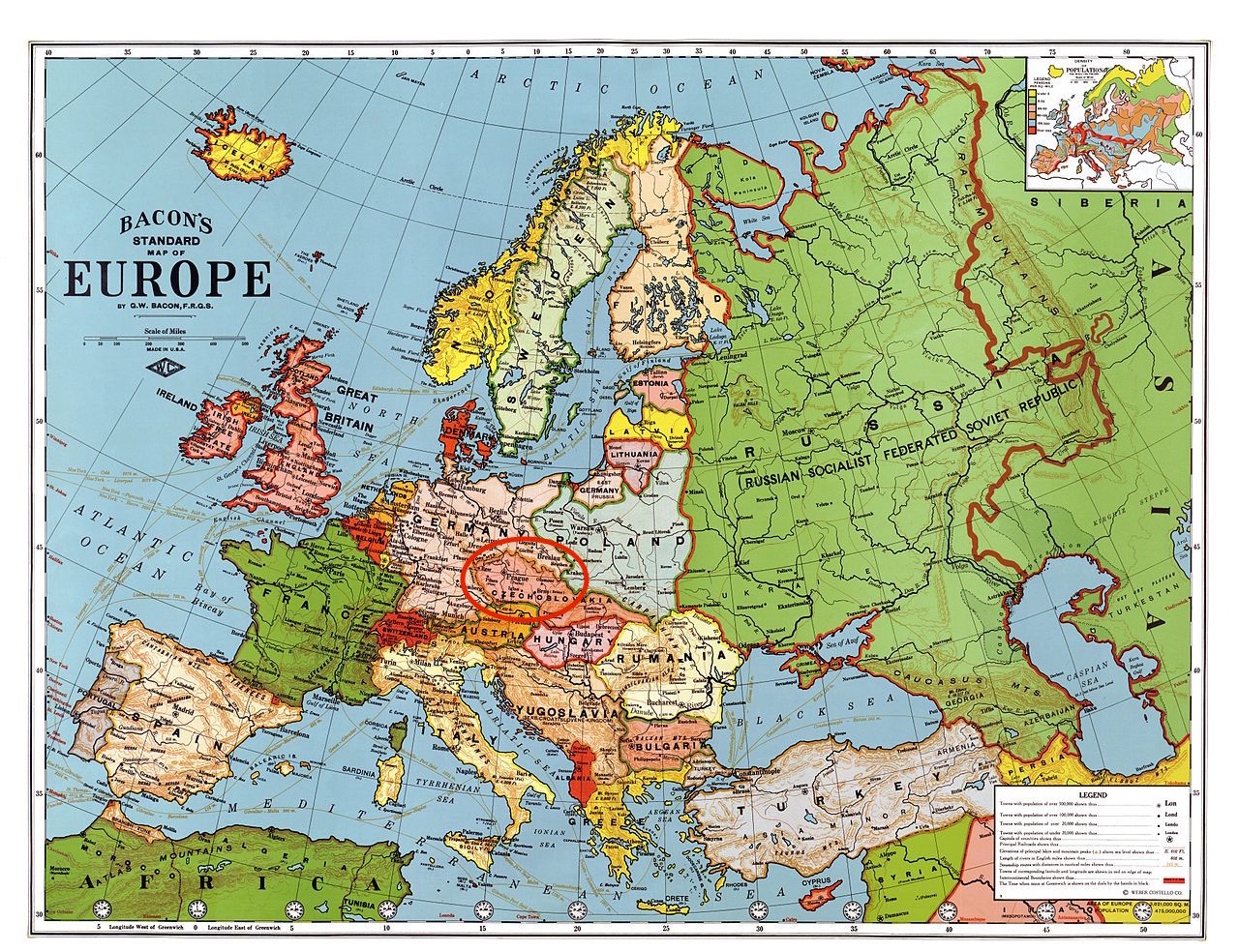
Europe in 1923 w. Sudetenland Circled, George Washington Bacon, Library of Congress’ Map & Geography Division
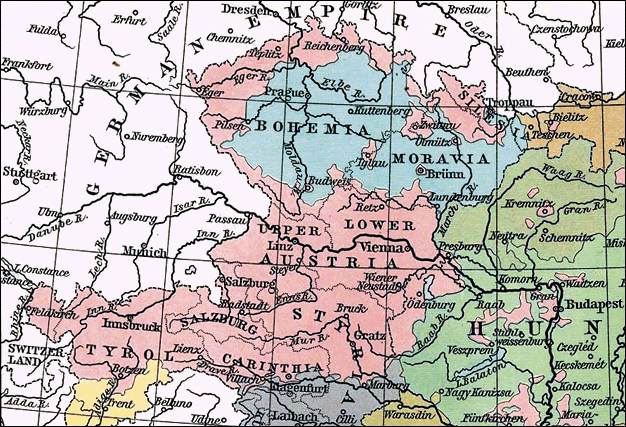
Ethnic distribution in Austria-Hungary in 1911: regions with a German majority are depicted in pink, those with Czech majorities in blue
Critics later derided Neville Chamberlain for his broken promise of “peace in our time” and Winston Churchill capitalized by returning to power as Britain’s Prime Minister. But Churchill’s argument that Britain missed its chance to stymie Hitler at Munich was unrealistic, at least minus the aforementioned three-way pact with the Americans and Soviets that he favored along with Davies and Stalin. Not only were British and French citizens desperate to avoid another war — and so far, they hadn’t been directly attacked — but Churchill himself wasn’t willing to open a western front once the war began! Should Chamberlain have been expected to open an eastern front even earlier or a western front to draw German forces from Czechoslovakia? Geography matters here.
Not everyone agrees that the Western Allies were less prepared in relation to Germany in 1938 than they were in 1939 or ’40. Hitler’s own generals argued at the Nuremberg Trials after the war that the Allies missed a chance to defeat Germany as late as 1938, pointing out that bad intelligence caused the Allies to overestimate the strength of German forces at the time. They’d supposedly tricked American spies and visitors into overestimating the size of their Luftwaffe, or air force. Some historians think likewise, arguing that Germany would’ve been easier to defeat in 1938 than after 1939. Even diplomat George Kennan, who later argued against over-applying the lessons of Munich, wrote here that Germany’s generals lacked confidence in their capacity to defeat the Czechs and were even considering a coup if Britain and France hadn’t capitulated at Munich. So, there was widespread disagreement as to Germany’s power circa 1938, and both sides’ military felt unprepared for war. British military intelligence tended to overestimate German strength prior to Munich and underestimate it after according to this line of thinking. Also, Germany occupied far more territory by 1940, including northern Europe, Poland, southeastern Europe, and North Africa, presumably making them harder to reign in, though their resources were spread thinner, partly offsetting this factor.
The classic appeasement-was-a-mistake interpretation of Munich isn’t necessarily wrong, but it needs to be predicated on this angle: that the Allies were stronger in relation to Germany proportionally in 1938 than they were by 1939-40. Without that critical premise, the argument falls apart and the Free World should be grateful that the maligned Chamberlain was in power rather than the revered Churchill. Churchill himself allowed for the advantages of buying time in his Second World War (1948-1953), writing that, as of 1938:
“No one could deny that we were hideously unprepared for war. Who had been more forward in proving this than I and my friends? Great Britain had allowed herself to be far surpassed by the strength of the German Air Force. All of our vulnerable points were unprotected…If Hitler was honest and a lasting peace had in fact been achieved, Chamberlain was right. If, unhappily, he had been deceived, at least we should gain a breathing space to repair the worst of our neglects.”
Why, then, did Churchill think that Munich was a mistake, both as it unfolded and in retrospect? Because, while the extra time aided Britain, allowing for arms buildup and the development of the Hurricane and Spitfire planes that defeated the Luftwaffe in the Battle of Britain two years later, the French army was stronger in relation to Germany in 1938 than they were two years later and Germany was able to recruit even more soldiers from the areas it conquered after 1938. But, also, Churchill was a political opportunist and used German aggression after Munich to gain power as prime minister over Chamberlain.
Churchill and Kennan’s calculations aside, the Munich Pact’s more simplified teleological critique is a classic case of “armchair quarterbacking” as American sports fans say, or criticizing only with the benefit of hindsight or being out of power. And even if Churchill and Kennan were right about Munich, it doesn’t follow that it’s smart to put “boots on the ground” as quickly as possible in every future scenario, as both men attested to. As for Ambassador Kennedy, who was also anti-Semitic, he clung too long to his German appeasement policy, ruining his presidential hopes with pessimistic comments about democracy’s bleak prospects. Meanwhile, his son John got around a medical disqualification and went on to command a PT (patrol torpedo) boat in the Pacific, bolstering his future political opportunities.
Absent any collective security with the Western Allies, Stalin worried that his army wasn’t strong enough to take on Hitler by himself. Germany signed a truce with the USSR whereby the countries agreed to not fight on an eastern front in any future war and to divvy up Poland, the country that lay between them. With the Nazi-Soviet Pact of 1939, Hitler was just stalling, giving his military time to catch its breath and grow stronger after taking Czechoslovakia and Austria. After a failed attempt to conquer Britain, he broke the truce and invaded the Soviet Union (USSR) in June 1941 with Operation Barbarossa, even after the Soviets helped supply Germany’s French invasion and Nazi officers attended a military parade in Moscow in May 1941. Hitler hoped to divide the USSR and acquire the oil fields of the Caucasus, in the country’s southern part. Seizing the oil would not only fuel the Third Reich but also paralyze the Soviet Red Army. The Nazi-Soviet Pact also brought a temporary end to the conflict between Japan and the USSR in Mongolia, since Japan was allied with Germany and Germany was allied with the USSR (for now).
The Western Allies never forgot Stalin’s willingness in 1939 to deflect German military aggression in their direction. Of course, Stalin could argue that the Western Allies had tried to do the same to him at Munich in 1938. Either way, when Hitler invaded the USSR in 1941, the Allies were slow to come to Stalin’s aid. By then they’d felt Germany’s wrath across Europe, from Poland to France, the Low Countries (Netherlands, Belgium, Luxembourg), Scandinavia, Greece, and Britain.
World War II in Europe
Germany’s Blitzkrieg (lightning warfare) invasion of Poland in September 1939 started World War II in Europe. In his Obersalzberg Speech on the battle’s eve, Hitler laid out his ruthless ambition to expand German territory:
Our strength consists in our speed and in our brutality. Genghis Khan led millions of women and children to slaughter—with premeditation and a happy heart. History sees in him solely the founder of a state. It’s a matter of indifference to me what a weak western European civilization will say about me. I have issued the command—and I’ll have anybody who utters but one word of criticism executed by a firing squad—that our war aim does not consist in reaching certain lines, but in the physical destruction of the enemy. Accordingly, I have placed my death-head formation in readiness—for the present only in the East—with orders to them to send to death mercilessly and without compassion, men, women, and children of Polish derivation and language. Only thus shall we gain the living space (Lebensraum) which we need. Who, after all, speaks to-day of the annihilation of the Armenians?
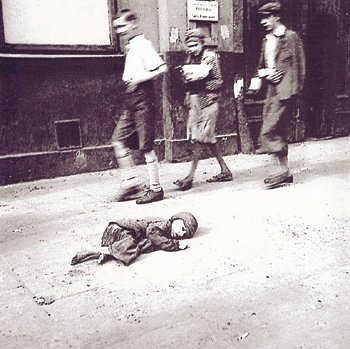
“A starving child lying in a ghetto street,” Warsaw Poland, by Heinz Joest, a Wehrmacht Sergeant, Yad Vashem Holocaust Memorial Museum, Israel
Italian dictator Benito Mussolini made similar comments in the Political & Social Doctrine of Fascism (1932). For Mussolini, peace was “born of the renunciation of the struggle and an act of cowardice in the face of sacrifice.” Two countries Germany invaded, Poland and Czechoslovakia, weren’t countries until the new map drawn up at Versailles in 1919, probably making them less resilient to attack. The Jewish child on the left is in the Warsaw Ghetto, where Germans rounded up almost the entire population and sent them to camps. After Poland’s invasion, France and Britain — still under the leadership of Neville Chamberlain — declared war on Germany, and Hitler turned his attention west after resting and rebuilding his forces during the Sitzkrieg. British called the Sitzkrieg the “Bore War” while American journalists dubbed it the “Phony War.” Germany conquered Denmark, Norway, and the Netherlands in April and May of 1940. British-led coalition forces under First Lord of the Admiralty Winston Churchill tried to stem the Norwegian invasion but failed, lowering Brits’ confidence in Chamberlain and leading to the ascension, ironically, of Churchill as the new Prime Minister. We’ve seen Churchill fail spectacularly at Gallipoli (Chapter 6) and as Chancellor of the Exchequer (Chapter 8) but he rose to the occasion during World War II, as we’ll see below.
The Axis Powers of Germany and Italy signed the Tripartite Pact with their imperial counterpart Japan in September 1940. Germany and Japan reinforced each other because Japan coveted the European-held colonies of Asia. Germany kept Britain, France, and the Netherlands at bay in Europe, making it impossible for them to defend their territories in Shanghai, British Hong Kong and Singapore, French Indochina (Vietnam), and the Dutch East Indies (Indonesia). The same dynamic explains why Hitler declared war on the United States days after Pearl Harbor, as we’ll see below. Prior to that, it wasn’t worth ramping up the quasi-war in the Atlantic enough to draw America into the European war, as happened in 1918. After Pearl Harbor, Hitler figured that the U.S. couldn’t fight two wars at once against Japan and Germany, so why not go all-out in the Atlantic to blockade Britain?
When Germany revved its war engine again in May 1940, they had an easier time invading France than they had in 1914. France built a series of bunkers along their shared border called the Maginot Line but didn’t anticipate that German tanks would daringly go through forested areas. Since this took longer, drivers fueled themselves with a methamphetamine stimulant called Pervitin — 35 million total tablets to be precise according to researcher Norman Ohler. After feigning an attack on more well-guarded portions of Belgium, Germany’s main divisions poured into the less defended Ardennes Forest, encircling French and British forces on the coast as part of their Manstein Plan. The Netherlands fell around the same time.
Desperate Allied forces from Britain, Belgium, Australia, and Canada fought with the French on the continent but had to be rescued from Dunkirk on the northeast French coast. The city was largely on fire, with its fuel tanks exploded, but German forces halted outside Dunkirk hoping their Luftwaffe Stuka dive-bombers could finish the job. The Stuka’s sirens wailed as they dove for psychological effect (Jericho-Trompete or “Jericho Trumpets” as the Germans called them). United Kingdom Prime Minister Winston Churchill refused to consider negotiating with Germany or Italy despite the advice of Foreign Secretary Lord Halifax. Anticipating the upcoming Battle of Britain and seemingly willing to cut some losses, Churchill also refused to expose too many Royal Navy ships to U-boat attacks and mines to rescue the trapped forces. Though harsh and demoralizing to those trapped with their backs to the North Sea, preserving most planes, ships, and troops was a key to future success because they “lived to fight another day.” Still, Churchill warned that wars weren’t won with retreats, and the British left most of their artillery, trucks, and tanks in German hands, along with ~ 50k troops (now POWs). The famous retreat is the subject of Dunkirk (2017) and Darkest Hour (2017), the former of which inadvertently whitewashes the affair by excluding the many Africans and South Asians in the British and French armies and British merchant fleet.
French forces fought hard for a while, but France’s conservative government failed to anticipate a Nazi attack because they thought they had a good relationship with Hitler, and the army was unable to pull their act together in time despite having more tanks and artillery than Germany. Within a matter of months, outnumbered, outgunned Nazis controlled two-thirds of France, setting up a collaborative government in the town of Vichy. They took over the entire country in December, 1942. Germany vengefully and symbolically forced France to sign off control of their country in the same train car in which they’d been forced to capitulate in 1918. Free French forces left the country to fight another day, while uncooperative citizens formed an underground resistance to courageously pester Nazis as best they could through railroad sabotage, car bombings, assassinations, etc.
B ritish Special Operations Executives infiltrated France with spies to help the French Resistance. Espionage became an important part of the war effort and the SOE often used unlikely agents as spies because they were less visible and likely to attract attention. One important radio operator working behind German lines in France, for instance, was Noor Inayat Khan, daughter of a Parisian Sufi instructor. She won the George Cross, the highest civilian wartime honor in the United Kingdom. The average life expectancy of radio operators behind enemy lines was six weeks and Khan died at Dachau concentration camp after relaying important messages for two years, refusing to relinquish details about her network even when tortured by interrogators. American-born jazz singer Josephine Baker (right) was another unlikely spy working in Vichy France. She relayed information in invisible ink on her sheet music and her profession offered a convenient cover for moving around the country. She also shared some secrets with the Free French that the Americans and British intended to keep to themselves because they didn’t trust their leader, Charles de Gaulle. In 2021, France inducted Baker into its Pantheon monument to historical heroes (AP). She personally raised the equivalent of over $11 million today to support the French Resistance against Nazi occupation. A third SOE spy that later worked directly for the OSS (precursor to the CIA) was American Virginia Hall. She relayed funding from the Allies to the French Resistance, overcoming the challenges of her prosthetic leg. Germans nicknamed her the “limping lady” and, for a while, she topped their most-wanted list. Their stories are just three of thousands that contributed to the Allies’ ultimate victory.
ritish Special Operations Executives infiltrated France with spies to help the French Resistance. Espionage became an important part of the war effort and the SOE often used unlikely agents as spies because they were less visible and likely to attract attention. One important radio operator working behind German lines in France, for instance, was Noor Inayat Khan, daughter of a Parisian Sufi instructor. She won the George Cross, the highest civilian wartime honor in the United Kingdom. The average life expectancy of radio operators behind enemy lines was six weeks and Khan died at Dachau concentration camp after relaying important messages for two years, refusing to relinquish details about her network even when tortured by interrogators. American-born jazz singer Josephine Baker (right) was another unlikely spy working in Vichy France. She relayed information in invisible ink on her sheet music and her profession offered a convenient cover for moving around the country. She also shared some secrets with the Free French that the Americans and British intended to keep to themselves because they didn’t trust their leader, Charles de Gaulle. In 2021, France inducted Baker into its Pantheon monument to historical heroes (AP). She personally raised the equivalent of over $11 million today to support the French Resistance against Nazi occupation. A third SOE spy that later worked directly for the OSS (precursor to the CIA) was American Virginia Hall. She relayed funding from the Allies to the French Resistance, overcoming the challenges of her prosthetic leg. Germans nicknamed her the “limping lady” and, for a while, she topped their most-wanted list. Their stories are just three of thousands that contributed to the Allies’ ultimate victory.
Winston Churchill couldn’t convince the French to destroy their navy as they retreated and he didn’t want it to end up in German hands. Thus in July 1940, Britain destroyed the French fleet and harbor at Mers-el-Kébir in Operation Catapult — an operation about half as large and deadly as the Japanese attack on Pearl Harbor in 1941. The attack helped win over FDR, who was impressed with Churchill’s ruthlessness.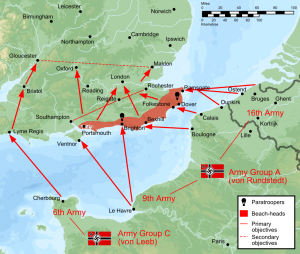
With Germany occupying most of France, the Low Countries, Scandinavia, and southeastern Europe after the Battle of Greece in April 1941, they now controlled nearly the entire continent. They reached an accord with Franco’s fascist regime in Spain, but not a formal alliance like they had with Italy. Swiss banks agreed to help finance the Reich in exchange for maintaining Switzerland’s traditional neutrality. Britain stood virtually alone as they fended off Hermann Göring’s Luftwaffe in the summer and fall of 1940. But, as relayed in the optional section below, the British fended off the German Blitzkrieg in the Battle of Britain, serving up Hitler his first real defeat. Operation Sea Lion (right), Germany’s proposed UK land invasion, never happened, stopping Germany’s momentum in the west, saving England from invasion, and arguably helping to defend America.
Instead, “stiff-upper-lipped” pilots, radar operators, munitions makers, and politicians — inventors of the original “Keep Calm & Carry On” posters and led by Winston Churchill flashing his “V for Victory” sign (right) — held off the Luftwaffe. Hitler finally gave up and decided to attack England with rockets launched from France as he focused his efforts on invading the USSR. Der Führer later pointed to the Battle of Britain as the turning point in the war. Frustrated at their inability to defeat Britain through the air, Germany turned east and invaded the Soviet Union in June 1941 in Operation Barbarossa, dishonoring the Nazi-Soviet Pact of 1939. Hitler had planned this all along, but only after defeating Britain first. Germany’s Soviet invasion was welcome news all considered for the Western Allies but, still, it didn’t clear up Atlantic shipping lanes. Britain was still losing the Battle of the Atlantic by the summer of 1941, as “Wolfpacks” of German U-boats wreaked havoc on shipping from North America to Britain.
Interwar America
Winston Churchill desperately sought an American alliance. He said, “Hitler knows that he will have to break us in this island or lose the war…If we fail, then the whole world, including the United States, including all that we have known and cared for, will sink into the abyss of a new Dark Age.” But in Depression-era America, there was only lukewarm concern for the Nazis’ onslaught.
Germany didn’t inspire much sympathy either. Despite its large German-American population, few Americans sided with them. The U.S. Nazi parties, the German American Bund and Free Society of Teutonia, were small and never posed a serious threat to U.S. security, despite being accepted enough to march in public parades (above); or, at least at seems like that in retrospect. The Bund ran 25 summer camps where young Nazis could hunt and fish and, similar to the German Lebensborn, blonde teenagers were encouraged to mate with each other. Their rallies changed FDR’s name to Frank D. Rosenfeld and called the New Deal the “Jew Deal.” The FBI, aided by undercover agents, tracked American Nazis in the late 1930s and rolled them up once war broke out, retaining some spies as double agents. New York’s District Attorney Thomas Dewey, later the GOP’s 1948 presidential candidate, had already prosecuted Bund leader Fritz Kuhn on embezzlement charges 1939.
But if Nazism never caught on, neither did most Americans favor intervention in another European war, especially because America’s stake in WWI was so muddled. Also, some American companies did business with the German Reich (e.g., GE, GM, Ford, DuPont, Kodak, Coca-Cola, Chase Bank, ITT, RCA, Gillette, and Standard Oil) and an IBM subsidiary made Hollerith punch cards to help the Nazis catalog and track the movements of Jews in Germany (IBM & the Holocaust). Standard Oil of New Jersey (later part of Exxon) sold to Germany as late as 1942. Like Ford, IBM’s Tom Watson was a Nazi favorite. General Motors’ Alfred Sloan sought contracts to motorize the German war machine via Opel, commenting that he “admired the strength, irrepressible determination and sheer magnitude of Hitler’s vision.” Sloan envied how much direct power corporations had in fascist governments.
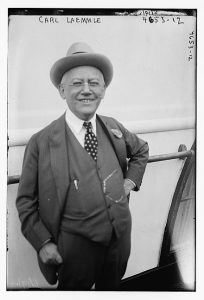 Hollywood, likewise, was hesitant at first to disrupt one of their best overseas markets. They used a clause in the 1934 Production Codes to “avoid offending (or slurring) citizens of any nation.” In this case, that meant crossing Joseph Goebbels’ Nazi Ministry of Popular Enlightenment and Propaganda. MGM usually screened their movies with Nazi leaders to make sure they were acceptable, since Europe represented ~33% of Hollywood’s market. They squelched a handful of informative documentaries. But, in the late 1930s, Jewish producers started to release films with negative portrayals of Nazis and their American sympathizers. With Confessions of a Nazi Spy (1939), Warner Brothers released the first American anti-Nazi movie aside from newsreels, after FDR pushed the State Department to remove restrictions. Carl Laemmie (left), founder of Universal Studios, personally sponsored hundreds of Jewish Holocaust refugees before the State Department and FDR cut off all refugees in 1938 to appease labor unions (just as they were authorizing anti-Nazi movies). The House Un-American Activities Committee — aka HUAC, supposedly tasked with blunting both communism and fascism in the U.S. — and the Senate Nye Committee both condemned Confessions of a Nazi Spy as anti-German and American Nazis in Milwaukee burned down a theater that showed it. The studio had to provide the movie’s star FBI agent, Edward G. Robinson, extra police protection. Senator Gerald Nye (R-ND), who gave that committee its name, argued that Hollywood Jews (e.g., the Warners, Laemmie, Louis B. Mayer of MGM) presented a bigger threat to American security than German Nazis. They weren’t a threat to America but, to their everlasting credit, they were a public relations headache for Hitler.
Hollywood, likewise, was hesitant at first to disrupt one of their best overseas markets. They used a clause in the 1934 Production Codes to “avoid offending (or slurring) citizens of any nation.” In this case, that meant crossing Joseph Goebbels’ Nazi Ministry of Popular Enlightenment and Propaganda. MGM usually screened their movies with Nazi leaders to make sure they were acceptable, since Europe represented ~33% of Hollywood’s market. They squelched a handful of informative documentaries. But, in the late 1930s, Jewish producers started to release films with negative portrayals of Nazis and their American sympathizers. With Confessions of a Nazi Spy (1939), Warner Brothers released the first American anti-Nazi movie aside from newsreels, after FDR pushed the State Department to remove restrictions. Carl Laemmie (left), founder of Universal Studios, personally sponsored hundreds of Jewish Holocaust refugees before the State Department and FDR cut off all refugees in 1938 to appease labor unions (just as they were authorizing anti-Nazi movies). The House Un-American Activities Committee — aka HUAC, supposedly tasked with blunting both communism and fascism in the U.S. — and the Senate Nye Committee both condemned Confessions of a Nazi Spy as anti-German and American Nazis in Milwaukee burned down a theater that showed it. The studio had to provide the movie’s star FBI agent, Edward G. Robinson, extra police protection. Senator Gerald Nye (R-ND), who gave that committee its name, argued that Hollywood Jews (e.g., the Warners, Laemmie, Louis B. Mayer of MGM) presented a bigger threat to American security than German Nazis. They weren’t a threat to America but, to their everlasting credit, they were a public relations headache for Hitler.
There’s a spirited scholarly debate about the extent of Hollywood studios’ collaboration with Nazis prior to 1938, before the Munich Conference, Austrian invasion, and Kristallnacht. Remember that, unlike 1930s Americans, we filter Nazis through the Holocaust and WWII. Comedian Charlie Chaplin, who was born the same week as Hitler in 1889 and had a similar mustache, loathed Nazis all along, and the feeling was mutual. Believing Chaplin was Jewish or at least a “pseudo-Jew,” Nazis derided the popular actor in Johann Von Leers’ 1933 book Jews Are Watching You and the book/movie The Eternal Jew (1937, 1940). Chaplin, in turn, lampooned Hitler in The Great Dictator (1940), that he even courageously hoped to debut in Berlin (he later said he wouldn’t have made the movie had he known about the concentration camps). But not all Americans approved of such provocative propaganda. Joseph Kennedy, Sr., who as American ambassador to the United Kingdom supported the Munich Pact, tried to persuade movie directors to lay off the Nazis. In his opinion, Jewish Americans like the Warners were conspiring to lure the U.S. into an unwinnable and unnecessary war against Germany.
President Franklin Roosevelt was more anxious to oppose Hitler than most of Congress and the American public in the late 1930s, but even FDR wasn’t yet a full-fledged hawk. Due to voters’ skepticism about WWI, the forenamed Congressional Nye Committee outlawed American intervention in foreign wars in 1935. In 1937, they even went so far as to outlaw American aid to any allies at war, with the third round of Neutrality Acts. Various American groups opposed intervention, including most conservatives, Southern and Midwestern farmers, and liberal student peace activists at Ivy League schools who espoused strength at home but no help for allies overseas. Gerald Nye, the committee’s namesake, was a Republican. Yale’s America First Committee lobbied for isolationism and a Fortress America strategy of simply defending American shores. They recruited celebrities like aviator Charles Lindbergh, actress Lillian Gish, poet Robert Frost, producer Walt Disney, architect Frank Lloyd Wright, and included future presidents Gerald Ford and John F. Kennedy. They borrowed their name from 19th-century railroads and national parks who urged visitors to “See America First” rather than sailing to Europe for vacation, and Woodrow Wilson’s initial defense of isolationism before the U.S. entered WWI in 1917 (ironically, Wilsonianism was later associated with the opposite outlook). Offshoot groups of mothers with black veils lobbied congressmen to stay out of European affairs, with some yelling at them in the Capitol hallways and even spitting in their faces. The GOP was divided; some accused Roosevelt’s administration of being Nazis or communists while the Wall Street Journal ran a pseudo-pro-Nazi editorial in 1940, “A Plea for Realism.” America First spun war hawks as a conspiracy of Jews, liberals (Roosevelts), and British.
After all, the U.S. did have two large oceans on either side of it; perhaps it was time to take George Washington’s 1796 Farewell Address advice and steer clear of overseas commitments. Many WWI veterans (e.g., Walt Disney) opposed any foreign intervention whatsoever. Even George Marshall, who later was Army Chief of Staff in WWII, opposed intervention until late 1941. Some bars near military bases banned soldiers. Generals testified on Capitol Hill in mufti (civilian clothes) to avoid provoking pacifist congressmen. Contrast either of those last two points with America post-9/11, when merely walking through an airport in uniform could elicit a spontaneous round of applause.
!["Is This What You Mean?" Herblock, 1939, Library of Congress "Is This What You Mean?" [by protection of two oceans in Fortress America model], Herblock, 1939, Library of Congress](https://sites.austincc.edu/caddis/wp-content/uploads/sites/106/2015/09/isolationismisthiswhatyoumeanherblock.jpg)
“Is This What You Mean?” [by protection of two oceans in Fortress America model], Herblock, 1939, Library of Congress
While the U.S. was never purely isolationist in the 1920s and ’30s, its military was small and it was relatively isolationist in comparison to the late 1910s and early ’40s. By mid-1941, around 75% of Americans opposed intervention in WWII. But isolationist sentiment was predicated on a divided Europe where countries would fight each other. By 1940, Europe was mostly unified under German control. Cartoonist Herblock captured the situation perfectly in the 1939 cartoon above. If Britain fell and Japan attacked, George Washington’s two-ocean buffer idea could easily turn into a pincer. FDR realized that sooner than others did. Working with a covert British propaganda office set up in New York by Churchill (British Security Co-ordination), he even went so far as to present a bogus map showing Germany’s intention to conquer the Western Hemisphere. People on the East Coast were naturally more concerned with Germany than were other parts of the country. South America, near the Panama Canal, was an additional concern because there were large German populations in Brazil and Argentina.
Hitler appreciated America for many reasons, including its natural resources, industrial strength, and racism. He admired Jim Crow, Indian reservations, and the 1924 Immigration Act. He thought the hardiest type of Germans were the very ones who emigrated and helped settle America. Nonetheless, Hitler’s unpublished second book suggests he wanted to conquer the U.S. after first consolidating Europe. FDR didn’t know about the book, so his map was still bogus, but he was on the right track that Germany posed a threat. You could say that FDR’s map was a fib on behalf of truth. Winston Churchill moved into the White House for weeks at a time to beg and plead that FDR take action. Hitler was now referring to Churchill, who was purportedly ¼ Mohawk Indian (his mother was American-born), as a “Jew-ridden American drunkard.”
Against the wishes of the Pentagon, who feared the president would get impeached if the ploy failed, FDR maneuvered around the Neutrality Acts by sending Britain destroyers, mainly, in exchange for little-used bases with a program called Lend-Lease. Lend-Lease lent military equipment to Britain under the promise that they’d return it someday, but also sent aid to China and the USSR. FDR likened the program to lending a garden hose to a neighbor to put out a fire. When the neighbor was finished they could return it and, if it was damaged, they could compensate; in the meantime, the important thing was dousing the flames. Lend-Lease ended up providing Britain with ¼ of its subsequent armaments during the war and Hitler mentioned it as a cause for declaring war on the U.S. on December 11, 1941. With Cash-And-Carry, America sold weapons at its shore for cash or gold as long as the buyer wasn’t German or Japanese. Britain also gave Americans a tour of MI6’s code-breaking facility at Bletchley Park, later shared by the Western Allies. The U.S. started their own intelligence agency a year later, 1942, with the Army’s OSS, forerunner to the CIA in 1947.
Britain, meanwhile, handed over eight of its North Atlantic and Caribbean bases to the U.S. and, most importantly for the long-term, dismantled its preferential trading system within the United Kingdom, opening up free trade for the U.S. down the road. That was a big concession for Winston Churchill because, according to some, it accelerated the ultimate collapse of Britain as the leading world economic power. Of the 50 destroyers that Britain received in exchange for the bases under Lend Lease, none were built after 1919 and only nine were fit for service, leading one British commentator to complain that “the exchange of real estate and harbour facilities for obsolete rust-buckets in which men would be killed showed up the distinction between those that were fighting the war and those that were profiting from it.” Many Brits believed that, prior to 1918, the U.S. had mainly just profited from munitions production and war loans during the Great War and now seemed to be doing the same thing. As we saw at the top of the chapter, the U.S. didn’t forgive British war debts in the 1920s and ’30s and resentment over that, combined with anti-Semitism, contributed to a popular English meme of Uncle Sam as Uncle Shylock, from Shakespeare’s Jewish banker in The Merchant of the Venice. The Special Relationship between Britain and the U.S. played up by postwar historians and commentators included enough underlying tension that British officials had to launch a propaganda campaign aimed at getting its citizens to like America. Actors like Laurence Olivier promoted Lend Lease while radio and school curricula taught Britons about American life, history, art, and popular music (folk, blues, and jazz), avoiding topics like the Neutrality Act and labor strikes that interfered with weapons production.
Mostly, its American relations in 1940-41 underscore Britain’s desperation. Not only did the British make generous economic concessions to the U.S., they shared important technology. Led by Henry Tizard, the British placed big orders with American manufacturers in exchange for giving America’s government blueprints and equipment pertaining to radar, jet engines, submarine detection devices, superchargers (to allow planes to fly higher and faster), plastic explosives, gyroscopic (Norton) gun sights to account for payload drop and wind, self-sealing fuel tanks (so planes could stay aloft after having their tank ruptured) and, most importantly, radioactive “super-bombs” (nukes). Already, the year before (1939) — more than two years before the U.S. entered the war — the Americans, British, and Canadians agreed to develop an atomic bomb with the Manhattan Project, hoping to beat Germany to the punch.
Finally, the Neutrality Act evaporated altogether as the U.S. occupied former British bases in Greenland and Iceland and Germany declared unrestricted submarine warfare in the Atlantic on merchant ships. The U.S. instituted a draft in 1940 after Germany conquered France. American war hawks saw Britain as its last bastion of defense in Europe and didn’t want the Royal Navy falling into German hands, just as Churchill didn’t want to lose the French navy to the Germans. Even before the U.S. was officially at war, they lost several merchant vessels in the Battle of the Atlantic. FDR even instructed the Navy to hound the Germans in hopes they’d strike back, to awaken the American public. German U-boats were under strict orders to not fire on American naval ships so as to not entice the U.S. into the war, as they had in WWI. These manufactured incidents baited the Germans into some small-scale attacks on American ships, including the USS Reuben James and USS Greer, but not enough to goad the public into favoring war with Germany. People saw through the manipulation and Teddy Roosevelt’s daughter Alice even said she’d vote for Hitler over her cousin FDR.
Still, the U.S. was now unrolling the fire-hoses for Britain, both figuratively and literally. They were shipping Britain actual fire-hoses and extending aid generally. FDR was slowly and deftly drawing the U.S. into a war its citizens weren’t ready for. During the 1940 campaign he promised the public that, despite Lend-Lease, no American boys would fight overseas as they had in the Great War. But both FDR and GOP candidate Wendell Willkie agreed that a draft was a good idea and Congress passed the resolution. FDR also poached key hawks from a Republican Party divided between hawks and isolationists, preparing to assemble a bipartisan wartime cabinet for his third term. In August 1941, four months before Pearl Harbor, FDR met Churchill aboard the HMS Prince of Wales off Newfoundland (map, right) to sign the Atlantic Charter, a pronouncement of their mutual dedication to protect democracy and promote liberal ideas globally after the war (critics said the charter was so vague that even Stalin later signed it; Churchill didn’t like it either but FDR had the money and weapons Britain needed). FDR also accepted American responsibility for protecting or trying to protect the shipping lanes between North America and Iceland, taking some pressure off the Royal Navy (green on map, right). Months before direct involvement, the U.S. was already losing ships, making promises about the postwar world, and drafting soldiers, and the government-subsidized munitions industry was pulling the U.S. out of the Great Depression. This was a key advantage to arming Britain: it pulled the U.S. out of the Great Depression more effectively than had New Deal programs.
Nonetheless, most of the country still wanted to steer clear of direct European entanglements. When Japan attacked Pearl Harbor, the U.S. Congress’s House Un-American Activities Committee (HUAC) was in the midst of investigating British film producer Alexander Korda for making propaganda films like Fire Over England (1937) about Elizabeth I’s heroic 1588 defense against the Spanish Armada and That Hamilton Woman (1941) about Admiral Horatio Nelson’s victory at Trafalgar in the Napoleonic Wars. HUAC was at least right that Korda and his go-to actors, Olivier and Vivian Leigh, were trying to counter America First’s isolationism. When Churchill showed That Hamilton Woman to Americans and officers aboard the HMS Prince of Wales, with its dialogue about not negotiating with dictators, it was obvious that Napoleon was standing in for Hitler. As of December 6, 1941, the day before Pearl Harbor, polls showed that most Americans favored neutrality.
 Back To Asia
Back To Asia
Meanwhile, the U.S. helped China fight Japan and even had a group of 100 volunteers, the Flying Tigers (AVG), supporting China’s Aviation Corps — reminiscent of the Lafayette Escadrille in France before the U.S. entered WWI, the Eagle Squadrons flying for the RAF during the Battle of Britain, and the 50+ Americans who’ve died in Ukraine since 2022. In their iconic Curtiss P-40 Warhawks, these early entrants into WWII helped draw off Japanese resources from their Pacific campaigns. The blood chit above explains to Chinese civilians that they should rescue, protect, and provide medical care to American pilots.
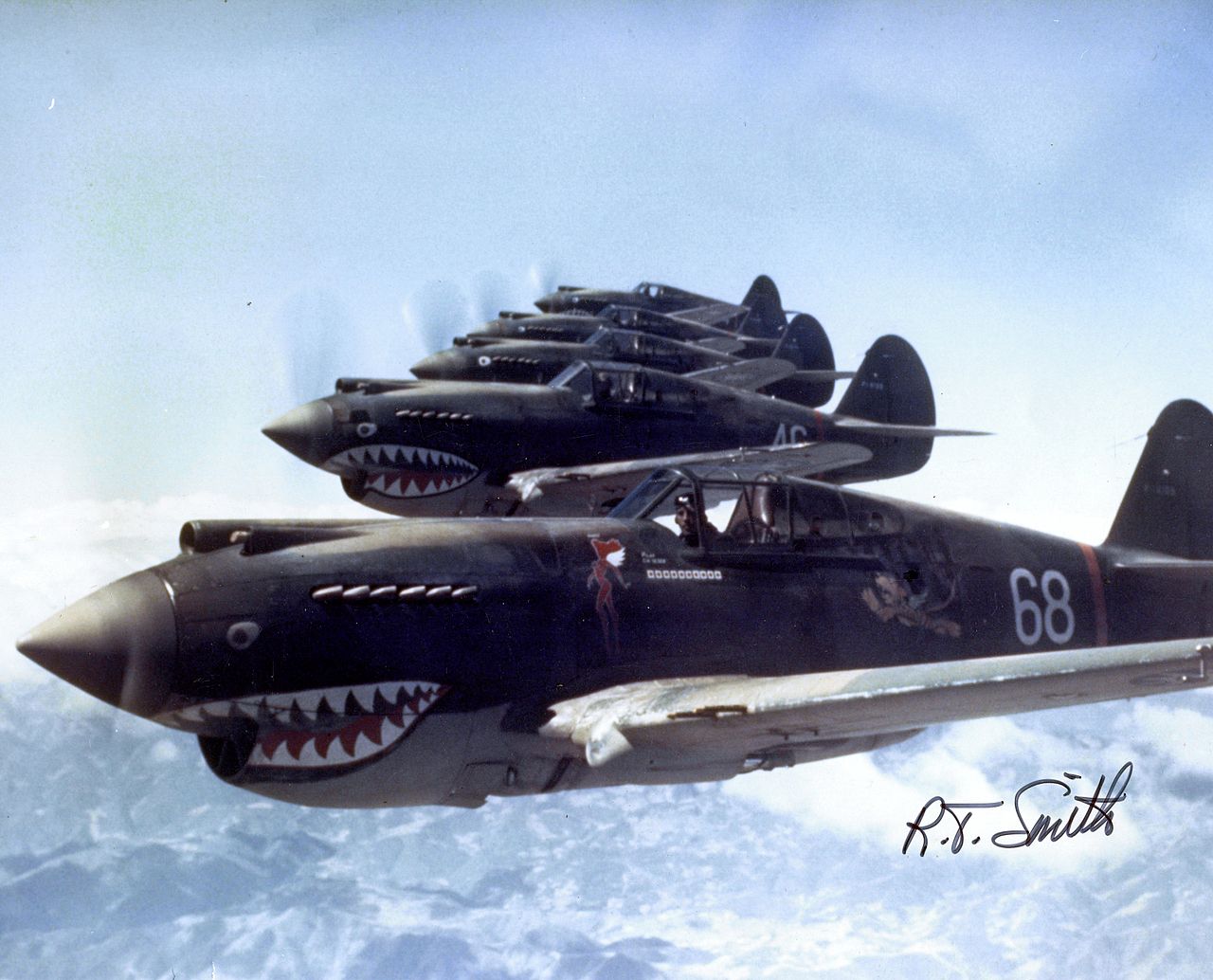
3rd Squadron Hell’s Angels Flying Tigers, 1942, San Diego Air & Space Museum Archive (this group later formed the famous motorcycle gang of the same name)
Marines in China learned to be “gung-ho,” to cooperate, though the term later morphed into meaning enthusiastic. But despite indications of tension between Japan and the U.S., American lobbies that stood to gain selling oil and metal to Japan were still dictating American policy, even as the U.S. sided with China. During the Moscow Trials of 1936-38 concerning a Trotskyist plot to overthrow Joseph Stalin, it came to light that Japan was working with the rebels and hoped to sign an oil deal with the new Russian leaders. That would relieve them of their dependence on American oil and allow them to stockpile reserves in the event of a future U.S. war. While those revelations didn’t do much to disrupt relations initially, and the Russian rebels were shot anyway in Stalin’s Great Purge, oil was indeed a key cause of war between Japan and the U.S., and a key reason for Germany’s defeat in the European war as we’ll see in coming chapters.
South of China, Japanese expansion into Indochina (Vietnam, Laos, and Cambodia) threatened American-held oil interests in nearby Indonesia, then known as the Dutch East Indies. The U.S. had already cut Japan off from aeronautical equipment in the “moral embargoes” after their China invasion. When Japan invaded northern Indochina and signed the Tripartite Pact with Germany in September 1940, the U.S. cut off aviation fuel and steel/scrap metal to both countries and froze Japanese assets in American banks. The U.S. had also sold millions of tons of scrap metal to Nazi Germany in the late 1930s. When Japan invaded southern Indochina in July 1941, American oil companies had seen enough, especially Socony Vacuum/Jersey Standard, a subsidiary of Standard, the company now known as ExxonMobil and Chevron. They had wells, refineries, and stations in Dutch Indonesia, and felt threatened by Japan’s invasion of Indochina to the west.
FDR “put the noose around Japan’s neck” just enough they’d feel the tug, by embargoing all crude oil unless Japan retreated out of Southeast Asia and China. Japan later claimed they considered this an act of war, which it wasn’t, but it did back them into a corner. As one historian put it, the “oil clock was ticking” on Japan after the embargo. They could offset America’s scrap metal embargo some by importing from Central and South America but were running out of fuel, the lifeblood of modern industry and militaries. They either had to give up their imperial ambitions and retreat, or go for broke and try to knock the U.S. and Britain out of the Pacific so that they could take the oil for themselves. Peru’s Japanese ambassador even told American Ambassador Joseph Grew that he overheard leaders discussing a sneak attack on Pearl Harbor later that year. As for Standard Oil, they returned FDR’s favor by continuing to deal with Nazi Germany behind the United States’ back.
Pearl Harbor
Japan’s leaders disagreed on what to do. Hawks in Parliament pushed for war while, prior to 1940, naval commander Isoroku Yamamoto feared “awakening the sleeping tiger” by provoking America. He had studied and worked in the U.S., spoke fluent English, and admired its culture and industrial capacity. He didn’t think Japan could win a prolonged war with America. Yamamoto adamantly opposed the alliance with Germany and supported the disarmament agreements with the West in the 1920s and ’30s, making him such an enemy of right-wing militarists that they considered assassinating him. Being named commander of the Combined Fleet likely saved his life as it temporarily put him out of harm’s way.
Japan resolved to deliver a preemptive knockout blow to the U.S. Navy by destroying its Pacific Fleet in Pearl Harbor, on Oahu — the spot that, thirty-five years earlier, Franklin’s cousin Teddy Roosevelt prophesied the Japanese would attack before trying to conquer the Philippines. Of course, before we declare TR too much of a Nostradamus on this score, we should note that Pearl Harbor was the main American naval base in the Pacific. Led by Admiral Harry Yarnell, the Navy ran their own mock raid on Pearl Harbor in 1932 (on a Sunday morning, no less) with biplanes taking off from aircraft carriers and dropping flares and flour sacks. Warner Brothers was even shooting a movie called Across the Pacific about a fictional Japanese attack on Pearl Harbor in the fall of 1941 that they moved to the Panama Canal when the real attack occurred on December 7th.
FDR moved the main fleet to Pearl Harbor from San Diego in 1940 to discourage Japanese aggression, but the opposite happened. His naval repositioning changed Admiral Yamamoto’s mind; he argued that, while its location in the central Pacific threatened Japan, so too it made it vulnerable to a Japanese attack. Yamamoto even hoped an effective attack’s impact would lower “the morale of the U.S. Navy and the American people…to such an extent that it cannot be recovered.” By fall 1941, Yamamoto was conflicted, still hoping for peace with the U.S. but favoring Pearl Harbor as the best way to poke the sleeping tiger if, indeed, the sleeping tiger must be poked. He even threatened to resign if the skeptical Chief of the Naval General Staff, Admiral Osami Nagano, didn’t approve the attack. Nagano feared a counter-attack would expose Japan’s carrier fleet. “What a strange position I find myself in,” Yamamoto wrote a friend, “having been assigned the mission diametrically opposed to my own personal opinion, with no choice but to push full speed in pursuance of that mission. Alas, is that fate?”
The U.S. learned that the main Japanese fleet had left Tokyo in late November but didn’t know where they were. Many analysts figured they’d attack the most vulnerable Americans stationed in the Philippines and some ships left Pearl Harbor to defend the Philippines, which was advantageous because they weren’t sunk. Roosevelt guessed they’d attack British Malaya (Malaysia) or Burma (Myanmar). Instead, six Japanese carriers were steaming toward Hawaii in an amazing feat of logistics. Sailing thousands of miles over rough seas, they had to refuel three times from supply tankers without breaking radio silence. As a decoy, Japanese diplomats flew to Washington to discuss a potential withdrawal from China. In Hawaii, Japanese tourists had gone up in planes and taken pictures of how the U.S. Navy arranged its boats and planes, huddled together for protection, so as to make them easier to guard. Unfortunately, that arrangement only made them more vulnerable to being destroyed in rapid succession. While U.S. Navy brass that favored destroyers over aircraft carriers ignored Harry Yarnell’s 1932 mock raid launched from carriers, Yamamoto didn’t. The Japanese even positioned their boats in the same place and followed his route of flying in from the northern part of Oahu on a Sunday morning. Taking advantage of their new alliance, Japan also used German intelligence to study the first real attack on a city launched from an aircraft carrier: the Royal Navy’s Battle of Taranto (Italy) in 1940. The U.S. Office of Navy Intelligence also had a map showing that the British used aerial torpedoes successfully in shallow water at Taranto, which was critical information that they should’ve passed on to the Navy at Pearl Harbor since they were under the false impression that their shallow waters precluded such an attack. Also, Japan’s navy had modified a new type of shallow-water torpedo that the U.S. didn’t know about.
On their way to Pearl Harbor, Japanese pilots were falsely told the U.S. had already declared war on Japan. As the attack commenced on December 7th, diplomats who’d supposedly come to Washington to talk peace delivered a letter to Secretary of State Cordell Hull accusing the U.S. of dishonoring Japan by refusing to recognize their sacrifices and effort to bring order, stability, and peace to Asia. Torpedo dive-bombers (Nakajima “Kates”) and fighters (Mitsubishi Zeros) attacked moored ships and air bases across Oahu in two waves. American underwater torpedo nets were down to make it easier for boats to get around the harbor.
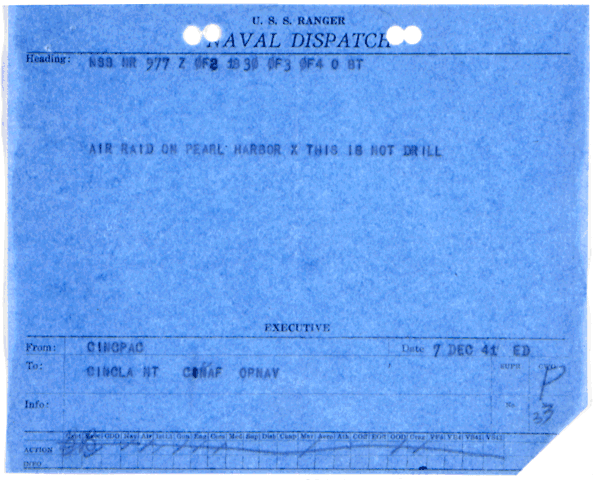
Naval Dispatch from the Commander in Chief Pacific (CINCPAC) Announcing the Japanese Attack on Pearl Harbor, 7 December 1941, John J. Ballentine Papers
The U.S. sank a Japanese sub off the coast an hour before the bombing started but commanders didn’t consider that an unusual enough occurrence that it indicated a broader attack. Radar operators also picked up some signals but radar was new at the time and their commanders wrote off the signals as American boats and planes arriving from the mainland. The serene Hawaiian setting created a sense of complacency on American bases and most soldiers and sailors were teenagers with no serious expectation of an imminent battle, especially a surprise attack when the two countries weren’t at war.
Two-thousand-four-hundred Americans died that Sunday morning, over half on the USS Arizona after a bomb ignited its forward magazine. Hundreds of sailors jumped off their boats into the harbor but much of it was covered with burning oil. The USS Oklahoma capsized, trapping its men underneath as water seeped into the compartments. When rescue workers cut through the hull later that night, their torches consumed what little oxygen was left. Other sailors were trapped for weeks and died in the hull of the USS West Virginia. When Hawaiians rushed to the bases to offer assistance, many were killed because of misidentification or friendly fire.
Like the 9/11 attack 60 years later, Pearl Harbor could’ve been far worse. Not only had three American carriers — the USS Lexington, Enterprise, and Saratoga — left the base, but the Japanese called off a final, third sortie that might have exploded the Navy’s fuel storage tanks at Ford Island, hindering America’s capacity to fight in 1942. And they missed the repair depots that the Navy used to fix damaged ships. The Japanese were also disappointed that the fleet wasn’t at the deeper harbor in Lahaina, Maui; because Pearl Harbor was shallower (only 30-40 ft.), the U.S. surfaced and salvaged most of its ships. All the American ships damaged at Pearl Harbor were in service at war’s end except the Arizona, Oklahoma, and Utah.
In retrospect, and hindsight is always 20/20, there were clues of an impending attack and mistakes made in failing to notify Hawaii as quickly as officials might have. However, contrary to common lore, there is no persuasive evidence that FDR knew about the location ahead of time and let it happen. He did tell Secretary of War Henry Stimson a week earlier that he thought Japan would attack somewhere and that he’d prefer that the U.S. maneuver Japan into firing the first shot without endangering Americans (Stimson Diary, 11.25.41). Conspiracy theories spread that FDR deliberately failed to warn the Navy, just as “Truthers” with overactive imaginations and weak standards of evidence blamed George W. Bush for planning 9/11.
There was enough evidence in Pearl Harbor’s case, though, to sustain reasonably plausible conspiracy theories. American Intelligence had at least a partially decoded a message from the Japanese navy to their embassy in Honolulu from September 24th, 1941 requesting information on Pearl Harbor ship location and geography. This so-called “bomb plot message” was never relayed to the U.S. Navy. Also, British agent Dušan Popov tried to warn FBI director J. Edgar Hoover that they had picked up on rumors of a Pearl Harbor attack and that the Japanese were asking Germany if they knew how the depth of Pearl Harbor compared to Taranto and if Pearl had anti-torpedo nets. Hoover was fascinated by the microdot technology Popov’s information was on but didn’t trust him because he was a double agent who also worked for Germany. Commanders in Hawaii never learned what Popov told the FBI (Popov may have helped inspire Ian Fleming’s James Bond, but he was likely a composite). One theory is that officials in Washington withheld — or at least, amidst bureaucratic confusion and ineptitude, never conveyed — vital intel to avoid revealing that they and/or the British had broken a Japanese code (JN-25 but not JN-25b), including information that Japanese were spying on Pearl Harbor and suggesting that they were planning an attack if negotiations didn’t improve by November 25th. But many historians are skeptical about how much progress the Allies had made on code-breaking at that point. Churchill wouldn’t have had any moral problem with such a ploy (remember the Lusitania), but wanted America fighting against Germany, not Japan. Communication was also poor between the Army and Navy. Ten days before December 7th, Chief of Naval Operations Harold Stark issued a general warning to all Pacific Navy bases that they suspected an attack somewhere. Japanese diplomats indicated to the Americans and British beforehand that war was imminent, arguing that to secure their empire, they “must take measures to secure the materials of the South Seas.”
Also like 9/11, finger-pointing commenced immediately after the attack, with officers on the ground in Hawaii rightfully blaming military brass in Washington for not keeping them fully informed and brass blaming the Hawaiian bases for being unprepared. The Roberts Commission scapegoated the leaders in charge of Pearl Harbor: Pacific Fleet Commander Husband Kimmel and Army Field Commander Walter Short, finding them guilty of dereliction of duty. In 1944, chief cryptologist Laurance Safford told Kimmel that top brass withheld background information from them to preserve knowledge of Operation Magic’s code-breaking. U.S. spies were too focused on Japanese diplomats, though, assuming they’d talk about specific war plans and not realizing that their military didn’t trust their foreign ministry with information. Still, information came in on the night of December 6th-7th indicating an attack and, by early in the morning, even the location. However, by the time everyone at Operation Magic got out of bed and Stark, FDR, and Army Chief of Staff George Marshall pieced the cobbled messages together, figured out what was going on, and transcribed each other’s messy handwriting, there wasn’t much time to warn Hawaii. The new short-wave radio technology failed because of weather, so they used an old radio-telegram station in California to send wireless Morse code. Kimmel got the telegram via Western Union from a bicycle courier seven hours after the attack, not even marked priority. Racism also contributed to America’s lack of preparedness, with Kimmel testifying before Congress that “I never thought those little yellow sons-of-bitches could pull off such an attack, so far from Japan.”
No, FDR didn’t deliberately withhold information about Pearl Harbor before the attack — a rumor hatched by the GOP during the 1944 election — but the blame that besmirched Kimmel and Short’s reputations should’ve been shared by their superiors. In any event, FDR had his wish of getting America into the war, even though he was disappointed that Germany wasn’t involved in the attack because Hitler concerned him more than the Japanese did (Germany and Japan were allies, though). Americans on the East Coast feared a connected German attack and New York City had two air raid sirens on December 8th that proved to be false alarms.
One problem with the Pearl Harbor conspiracy theories is that they don’t explain why the U.S. would’ve allowed the Japanese to follow through successfully. After all, a mere Japanese attempt at attacking Hawaii would’ve been enough to pull the U.S. into the war if that was FDR’s goal, since Japan was a German ally, but then the U.S. could’ve taken advantage of its knowledge and used it against Japan on December 7 the same way they would at Midway the following year (next chapter).
Gradually, FDR came to realize the Pearl Harbor attack’s magnitude. Having served as Assistant Secretary of the Navy, he was familiar with the specific ships that went down. He had personally laid the keel for the USS Arizona. Roosevelt worried that his legacy would be overseeing the worst day in that branch’s history, with the Navy having lost more sailors on December 7th than they had during all of WWI. After struggling for hours to get through, the White House finally made contact with General Douglas MacArthur in the Philippines to warn him that they were probably next. MacArthur, who fancied himself as having keen insight into the “oriental mind,” assured them that nothing similar would happen on his watch.
Americans united around the war effort. Pacifists dwindled to insignificant numbers as all 450 chapters of America First disbanded. Charles Lindbergh, for instance, flew missions against Japan. Henry Ford severed ties with Nazi Germany, apologized for his publication of the International Jew (Chapter 7), and renounced anti-Semitism. John Kennedy enlisted, lying about his poor health. Republican leadership, including FDR’s opponent in the 1940 election, Wendell Willkie, rallied around Roosevelt and the war effort.
FDR explained to his cabinet that the U.S. was on the verge of its biggest conflict since the Civil War, even as he soft-pedaled details about the attack’s severity. Three of Roosevelt’s sons volunteered for combat that day. With all his writers out of town for the weekend, FDR set about writing a speech he delivered to a joint session of Congress the next day. The cabinet tossed around the idea of declaring war on all three Axis Powers (Japan, Germany, and Italy), but decided to focus just on Japan. FDR’s Secretary of State Cordell Hull (D) and Secretary of War Stimson (R) were dismayed that the speech was so short. They wanted a thorough case made against Japan, including a laundry list of Japanese transgressions, more similar to Jefferson’s 1776 Declaration against Britain. But FDR wisely chose to keep it short and simple, overriding the unanimous advice of his senior cabinet. As he worked on the speech, a doctor rubbed cocaine along his nasal membrane to clear his sinuses, while Eleanor spoke first to the public on the radio about Pearl Harbor. She laid the groundwork for Franklin’s speech the next day by explaining in her most famous fireside chat that Americans would be sacrificing their lives for the country in a long upcoming struggle.
By the time FDR awoke the next day to give his “Day of Infamy” Speech, Winston Churchill had already declared war on Japan after he learned that they also attacked British forces in the southwest Pacific. While General MacArthur had assured FDR he was on full alert in the Philippines, he was inexplicably caught off guard by a Japanese attack there that wiped out half his air corps before it got off the ground. Yet, unlike the Hawaiian commanders who had no warning, “Mac” kept his job and went on to become a war hero.
It had been a long 24 hours for FDR, considering that early on the afternoon of December 7th, he’d been working on his stamp collection. The Treasury Department lent gangster Al Capone’s old car with bulletproof windows to escort FDR to the capital because they weren’t sure if Japanese spies would try to assassinate him. At this point, no one knew if the Japanese were on the verge of attacking the West Coast or what would happen next. With his trademark leg braces, cane, and son at his side to support him, FDR entered the House Chamber and slowly limped to the podium to rally the largest audience in American radio history.
Congress declared war within an hour, whereas WWI had taken four days. Hitler figured that the U.S. could hardly fight two wars at once, and Germany declared war on America days later. Hitler thought the war was won, especially given that Japan hadn’t lost a war in three-thousand years. Now Germany could freely disrupt American shipping to Britain and the U.S. would presumably be too preoccupied with Japan to offset that advantage by threatening Germany. In addition, Germany was allied with Japan as part of their Tripartite Pact and their alliance mandated that Germany and Italy declare war on the U.S. since America was at war with Japan. Hitler reaffirmed his support of Japan after Pearl Harbor. He’d been trashing and mocking FDR’s speeches since April 1939 as his infatuation with America evaporated. He dreamed of bombing New York City and said, “My feelings against America are those of hatred and repugnance – half-Judaized, half-negrified, with everything built on the dollar.” The propaganda poster below shows the conflicted and warped Nazi view of the U.S., simultaneously critical of both the KKK and African Americans (the jazz record). Nearly overnight, America found itself in two wars at once.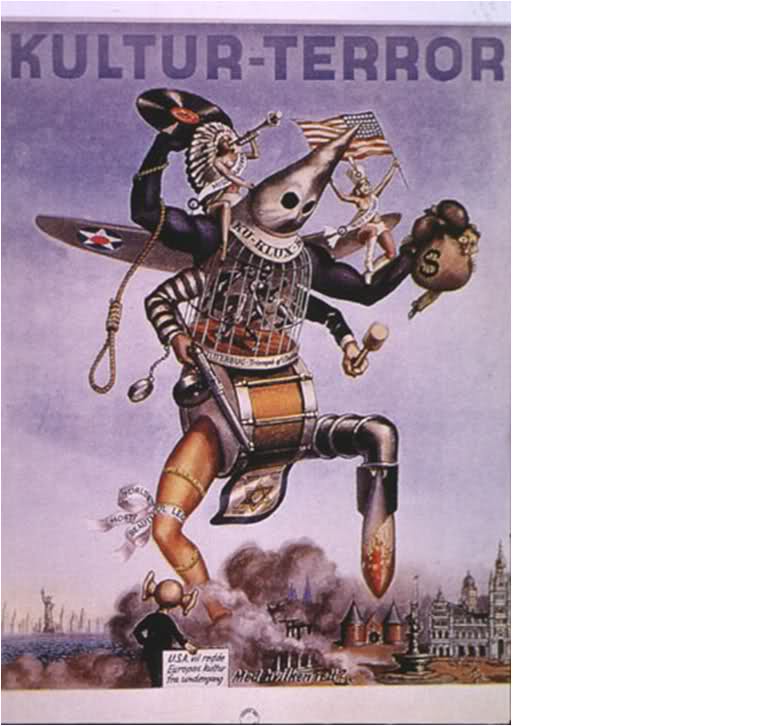
Optional Reading & Viewing:
Inter-War Diplomacy, 1921-1936, State Department, Office of the Historian
Diplomacy & the Road to Another War, 1937-1945, State Department, Office of the Historian
U.S. Holocaust Museum, Smithsonian
Rafael Medoff, “FDR’s Jewish Problem — And Its Japanese Link,” Jewish Journal, 2.11.22
Rafael Medoff, “Why FDR Wouldn’t Condemn Hitler,” History News Network, 4.28.19
Joshua Zeitz, “How World War II Almost Broke America,” Politico, 6.6.19
Becky Evans, “Paris Through a Nazi’s Lens,” Daily Mail, 9.11.13
Nick Baumann, “Chamberlain Was Right,” Slate, 9.28.18
Alvin Finkel, “Lessons of Munich,” Origins, 9.9.98
Geoffrey Wheatcroft, “On the Uses and Abuses of Munich,” New Republic, 12.3.13
Walter Russell Mead, “The Churchill Complex,” Wall Street Journal Book Review Of Buruma, 8.20
Richard Brownell, “The Tizard Mission: The Briefcase That Changed World War II,” WETA History Blog
Ian Toll, “A Reluctant Enemy,” [Yamamoto], New York Times, 12.6.11
David Kahn, “The Intelligence Failure of Pearl Harbor,” Foreign Affairs, 1991 (JSTOR Login Required)
Caesar Nafrada & Joseph Caddell, “‘Never Thought They Could Pull Off Such An Attack:’ Prejudice & Pearl Harbor” War on the Rocks, 12.7.21
Nazi Ideology: Anti-Semitism, Religion, Science, Philosophy, Eugenics
Nazi interpretation of Judaism drew on The Protocols of the Elders of Zion, a forgery that described a Jewish conspiracy to dominate the world and control finance and the media while fostering religious conflict. Numerous credible papers like the London Times and New York Times investigated it at the time and declared it a complete hoax. There never was any such thing as the “Elders of Zion.” But it was the same heap of trash that Henry Ford and the KKK published half a million copies of in the U.S. and it lives on today among neo-Nazis and in the Middle East among militant Muslims. While Ford was a brilliant engineer and businessman and Hitler a brilliant politician, they were both too undiscriminating as readers/thinkers to understand that Protocols was malarky. It had primary sources, at least, but they were fake. How could Jews take over the world with only 1.7% of even Europe’s population and why would they want to? Protocols’ author understood that often the market for a book’s ideas trumps its validity and was playing to readers’ emotional disposition toward anti-Semitism.
Another hallmark of successful propaganda is to deflect attention by projecting one’s own agenda onto the opponent (e.g., the idea that scientists who believe in anthropogenic climate change are only motivated by profit motive). Somebody was promoting religious conflict, all right, but it wasn’t European Jews; it was Nazis. Inspired by Protocols, Nazis published a similarly inspired propagandist newspaper called the Völkischer Beobachter that served as the official voice of the party for a quarter-century, from 1920-45.
Moreover, Nazis really were conspiring to dominate the world. Mein Kampf laid out a blueprint for future domination by vigorous, blonde, racially pure Aryans descended from a mythical pre-Roman race of giants. For Hitler, racial mixing had deprived the Aryans of their supernatural powers, with Jews being the primary genetic drag. Like the Elders of Zion, “Aryans” never existed as far as any serious scholar can tell. Hitler had soaked up the anti-Semitism of his native Austria more than most and wanted to ethnically cleanse Germany and Europe as a whole. Nazis kept it under wraps that Hitler couldn’t meet their own standard of ethnic purity by disproving the Judaism of all four grandparents. One influence on Hitler’s anti-Semitism in Vienna was occultist poet Guido Von List, a figure still revered by some neo-Nazis.
Hitler’s religion, like his economics, was ambiguous and disputed to this day. He remained a Catholic until the end of his life but he privately expressed animosity toward the Church. Der Führer also criticized atheists as enemies of the state, later using that as a pretext for waging war on the USSR, and claimed in Mein Kampf that he was “doing the work of the Lord” by “defending himself against the Jew.” But there was really only room for one messiah in Nazi Germany. Schoolchildren learned and recited that Hitler himself was the savior in their pledge of allegiance. Some Catholics defiantly rejected the Nazis and never cooperated. They, along with Protestants who spoke out, were sent to concentration camps with Jews. The Catholic Church as a whole, though, signed a 1933 Concordat (agreement) guaranteeing that they could regulate their own affairs in exchange for not challenging or resisting the Nazis. International Jews supported economic boycotts for a while but, after the Haavara Agreement in 1933, Zionist organizations called off the boycotts in exchange for Nazis transferring 60k Jew immigrants and $100 million in assets to Jewish Palestine.
Nazis mined and misinterpreted the religions, philosophy, history, and science around them for their worst aspects, brewing them into their own diabolical ideology. From Christianity, they took anti-Semitism. Building on that long-standing foundation of religious anti-Judaism through their “Positive Christianity,” they displayed copies of Protestant reformer Martin Luther’s On the Lies of the Jews (1543) at their rallies and celebrated Luthertag (Reformation Day) to underscore the connection. Luther’s diatribe called for their expulsion on the severest terms and reinforced negative imagery of Jews as “full of the devil’s feces…which they wallow in like swine.” German nationalists built the Martin Luther Memorial Church in suburban Berlin that was taken over by Nazis in the 1930s. Yet, around the same time that Nazis were cherry-picking Luther’s anti-Semitism, one American visiting Germany saw inspiration instead of hate, attracted to Luther’s peaceful revolt against authority. Michael King changed his name to Martin Luther King, Sr. and his son’s name to Martin Luther King, Jr. As for Catholics, they not only signed the 1933 Concordat; Church doctrine taught that Jews were “Christ-killers” until 1965. We should be careful, though, not to draw too deterministic a line from Christian anti-Semitism to Nazism (see Rear Defogger 26-9 in the menu above).
Nazis hoped that Positive Christianity would transition to a new Nazi faith. Beyond spinning and subverting mainstream religion on their behalf, they added a healthy sprinkling of occult nonsense, in the tradition of Guido Von List. More so than religious anti-Semitism, Nazis played on modern racial and economic anti-Semitism. They tapped into modern Gentiles’ resentment that Jews were disproportionately represented in high-profile fields like banking, journalism, entertainment, and retail ownership. Many German Jews were relative newcomers, having escaped the Russian pogroms of 1903-06, and being outsiders raised suspicions in Germany and Austria. When Hitler was a young man in Vienna, the city’s mayor Karl Lueger pandered to Gentile Austrians’ xenophobia. Jewish involvement in finance and ownership of gold, especially among high-profile wealthy families like the Rothschilds and Ephrussis, seemed to underscore their transient status as they were less tied to the country through land ownership and local currency.
Hitler stressed that Jews, along with communists, were responsible for Germany’s downfall in WWI, though neither played any demonstrable role that historians can see, and neither constituted a large percentage of the population. The German Communist Party, or KPD, rarely polled over 10-15%; the German Jewish population was ~ 0.75%. Nazis likened both Judaism and communism to cancerous growths that had to be eradicated from the body politic. (When German researchers discovered that smoking caused actual cancer during World War II, they kept it under wraps hoping that the popular habit would kill off people in opposing countries like Britain and the U.S.)
From philosophy, Nazis drew on a key misinterpretation of Friedrich Nietzsche: his sister reversed Friedrich’s scathing condemnation of anti-Semitism when she translated his work after his death. They also took Nietzsche’s idea of the Übermensch who rises above the common herd and its old-fashioned black-and-white notions of morality and applied it to Aryanism. Taking a cue from Guido Von List, they also modified the swastika flag symbol (upper left) from older symbols representing good luck, or well-being.
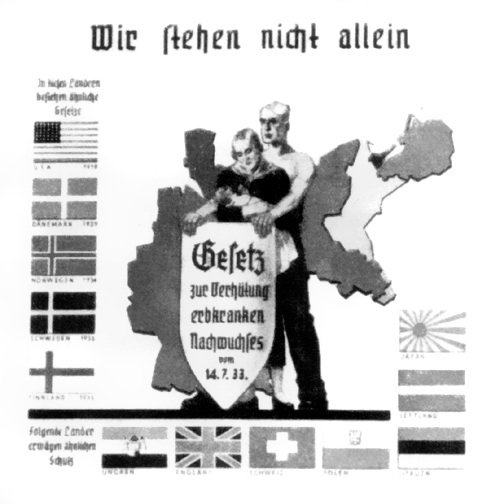
The woman is holding a baby and the man is holding a shield inscribed with the title of Nazi Germany’s 1933 Law for the Prevention of Hereditarily Diseased Offspring (their compulsory sterilization law). The couple is in front of a map of Germany, surrounded by the flags of nations which had enacted (to the left) or were considering (bottom and to the right) similar legislation.
From science and history, Nazis espoused a crude version of survival-of-the-fittest evolutionary theory and grafted it onto society, reducing history to a biological struggle. As was the case elsewhere, lesser minds transformed Darwin’s real science of natural selection into racist social science and back into pseudo-science. That pseudo-science was known as eugenics, the point of which (at the time, at least) was to study why everyone else in the world was inferior to blond-haired, blue-eyed Nordic Europeans and then use that science to justify ethnic cleansing.
As we saw in Chapter 4, biological racism went back centuries and predated both Darwin and the American eugenics movement. But South Africa, Sweden (Uppsala University), and the U.S. were epicenters of eugenic research and policy in the early 20th century. Sweden continued a sterilization program on its criminals and mentally ill until 1975. California eugenicists translated their works into German and circulated them among Nazi officials. One told a fellow colleague after returning from Germany, “Everywhere I sensed that their opinions have been tremendously stimulated by American thought…I want you, dear friend, to carry this thought with you for the rest of your life, that you have really jolted into action a great government of 60 million people.” California eugenicists published Nazi literature, in turn, and arranged for an exhibit on Nazi science at the Los Angeles County Museum for the American Public Health Association’s annual meeting in August 1934. The superintendent of Virginia’s Western State Hospital worried that “the Germans are beating us at our own game.” Leon Whitney of the American Eugenics Society bemoaned that, “while we were pussy-footing around…the Germans were calling a spade a spade.” These critics might have been underselling American impact. Harry Laughlin, the father of eugenics in the U.S., was awarded an honorary doctorate at Heidelberg University for his work on the “science of racial cleansing.” The poster on the right translates into We Are Not Alone, referring to other countries with sterilization laws. Hitler wrote admiringly of America’s racist immigration policies in Mein Kampf (1924) and wrote a letter to American eugenicist Madison Grant, calling his book The Passing of the Great Race (1916) “my bible.” Historian Edwin Black has shown that the Rockefeller Foundation and the Carnegie Institution seeded eugenic research in Germany. The Rockefellers funded Josef the “Angel of Death” Mengele’s research before he moved to the Auschwitz concentration camp. American support for eugenics, both intellectual and scientific, came before Americans knew that Germans had expanded their agenda beyond sterilization and breeding programs to eugenicide, or extermination.
Acutely aware of history, as are all totalitarian movements, Nazis situated their new regime as the latest German empire, the 3rd Reich, succeeding the Holy Roman Empire and modern German empire of 1871-1918. They also embraced idealized versions of medieval chivalry and knighthood. For scholarly credentials on the geopolitical need and justification for conquering Europe, they relied on Karl Haushofer, who wrote his Ph.D. dissertation on Japanese militarism and taught future Deputy Führer Rudolph Hess at Munich University. He stressed Germany’s need to compete with Britain’s Royal Navy by dominating sea-lanes in the North Sea, Mediterranean, and Suez Canal. Haushofer met Hitler through Hess and helped convince Hitler to ally the European Axis Powers, Germany, and Italy, with Japan in 1940. (The professor’s son was later involved in a plot to kill Hitler in 1944.)
Heinrich Himmler led what was essentially a pagan cult, replete with rituals, rings, and Wewelsburg Castle that would become the “center of the new world” after the “final victory” — similar to King Arthur’s Camelot. Himmler was brazenly anti-Christian. The only Christian element in the SS was its obsession with the Holy Grail, a medieval legend that connects to the Holy Chalice of Christ’s Last Supper. Yet, Nazi/SS ideology retained the basic framework of a messiah and scripture. Heil Hitler, the Nazi salute, meant not just hail, as in “Hail Caesar,” but also heal. German citizens attracted to Nazism hoped to be healed, spiritually, from the wounds inflicted by WWI and the Depression. According to their theory, Himmler was the priest of a new, forward-thinking state religion that would expunge the “plague” of Christianity, with Hitler as the new messiah and Mein Kampf as the holy book. Hitler also obsessed over and took possession of the Holy Lance purported to have pierced Christ’s side on the cross. An academic unit at Wewelsburg called the Ahnenerbe challenged traditional universities, whose denial of the Aryan’s existence was supposedly warped by Jewish influence. They interpreted runestones and traveled as far as the Tibetan Himalayas to find “evidence” of Aryan history.
Battle of Britain
In the Battle of Britain, the Luftwaffe bombed English ports, airfields, and infrastructure along with Scottish shipyards from June through October 1940. The bombings were supposed to set the stage for a land invasion called Operation Sea Lion. This was not a purely aerial war, as it was fought on land and sea, too, and Britain’s Royal Navy was superior to the German Kriegsmarine. German U-Boats were feared for good reason, but they didn’t have enough at the time to choke off Britain and small English fishing boats — the same ones used to rescue soldiers at Dunkirk — mounted guns and served as minesweepers and eyes and ears.
In the air, the Royal Air Force (RAF) stood as the last line of defense for the Free World. Two planes key for Britain’s survival were Hawker Hurricane and Spitfire fighters. On the face of it, these planes were inferior to the German Bf Messerschmitt 109’s they encountered in dogfights over the English Channel and countryside. The “Me 109’s” could fire superior 20mm cannon shells for a continuous minute and had aerodynamic “high-lift” slats on their wings. Also, British carbureted engines stalled in free-fall, whereas the Messerschmitts’ fuel-injected inverted V-12’s allowed them to out-maneuver, getting above or behind Spitfires and Hurricanes to fire. RAF pilots feared the “Hun in the Sun” and jerry-rigged rearview mirrors from their cars. However, the British proved their superiority in manufacturing quantity. German engineering set the pace, but they valued quality over quantity whereas the RAF ramped up production, replacing their lost planes. American and British factories made weapons ’round the clock in three shifts, seven days a week, whereas German plants, with its able-bodied population spread thin and slaves on many assembly lines, ran one eight-hour shift on weekdays.
Spitfires were the fastest planes in Europe at the time, with their Rolls-Royce engines stronger than the Messerschmitts that had to slow down to escort Stuka dive-bombers, mitigating their advantage in terms of maneuverability. Germans also had to concern themselves with running out of gas, unlike their RAF counterparts who didn’t have to fly home across the English Channel. They only had ten minutes of combat to spare over England or risk ditching at sea. German pilot diaries written from their base in northern France indicate these trips back and forth grew wearisome as they feared going to their watery graves in the bottom of the Channel.
The Luftwaffe never eliminated enough British planes on the ground the way they had in short order against Poland in 1939. The RAF posed more of a challenge than Germany planned for and, without air superiority, there was no hope of a land invasion. The Brits flew pilots from other occupied countries along with their own, including Poland, Czechoslovakia, the U.S. (Eagle Squadrons), and Free France, and United Kingdom airmen from Canada, New Zealand, South Africa, and Ireland. Polish pilots were renowned for their skill and close-range dogfighting style.
The RAF and Royal Observer Corps’ rudimentary but robust communication network, manned by men and women of all ages, repaired itself quickly. Like the Internet, breaking any one link couldn’t sever the network of Fighter Command radar stations, plotting tables, and amateur observer posts. It was called the Dowding System after its organizer, Commander “Stuffy” Dowding. The Germans underestimated their capacity to damage the radar stations because they mistakenly thought most were underground. Moreover, the British learned to jam the German pilots’ navigation systems.
Dogfights in the Battle of Britain overlapped with civilian attacks on England’s industrial cities known as the “Blitz.” Citizens scurried into subways and shelters during the bombing raids, re-emerging the next morning to put out fires and care for the dead and wounded (color slide show). The British had a horrifying, if brief, preview in World War I when giant German Zeppelins hovered over London dropping incendiary bombs, but they thwarted those attacks by blowing up the helium balloons. German bombers also attacked London in 1918, killing ~1400 people. Londoners were primed for more attacks, fearing that in the next war “the bomber will always get through.” Science fiction writer H.G. Wells’ The Shape of Things to Come (1933, film 1936) foretold cities being laid to waste from aerial bombardment. Unlike Paris or Berlin, London had a vulnerable approach from the English Channel by enemy pilots who merely had to follow the Thames River west a few miles inland. Eventually, the British built offshore radar-operated anti-aircraft batteries in the Thames Estuary and North Sea to block that route, some of which are still standing and hosted pirate radio in the 1960s when the government limited airwaves to classical music.
The WWII Blitz killed far more civilians than the WWI bombings. Forty-thousand “direct hit” citizens died and another 45k were injured among the “near misses” who survived. However, psychologists discovered that “remote misses” (nearby people who didn’t get hit) were only emboldened and invigorated in their fight against Germany, even less likely to give up than if they’d never experienced the bombardment. Prime Minister Winston Churchill said that “nothing was so exhilarating as being shot at without result.”
According to one theory, the original German plan was strategic infrastructure bombing only, but one pilot accidentally dropped his payload on citizens in London. Churchill retaliated by bombing Berlin, leading to the harsher Blitz against Britain. Hitler lost his temper and had Göring put too much focus on the civilian attacks, losing momentum in their campaign to destroy airfields and ports.
Brits also got moral support over the airwaves. Children’s fantasy writer and English professor C.S. Lewis broadcast a series of Christian apologetics later compiled in Mere Christianity (1952), which is still read in theology seminars and Sunday schools. The king and prime minister rallied the country politically. George VI, father of Elizabeth II, struggled to overcome his stutter well enough to speak on the radio, as dramatized in The King’s Speech (2010), while his brother and Nazi sympathizer Prince Edward (Duke of Windsor) relayed to Germany that continued bombing might weaken the English to the point of capitulation. Churchill revived his career during WWII after winning election in 1940. He gave inspirational radio speeches from rooftops though, for years, there were rumors that really he was safe in an underground bunker and someone else did the voiceover anyway because he was usually drunk. But Churchill’s “underground” war room was really only 12 feet underground, unbeknownst to Germany only a hundred yards from his residence at 10 Downing Street. It could’ve been obliterated on any night by a well-placed Luftwaffe bomb. His chair in the war room still has scars where he dug in his ring and fingernails during the Blitz, and visitors today can view the broom closet labeled “Churchill’s lavatory” where he maintained a special phone line to Roosevelt’s White House routed through a scrambler in the basement of Selfridge’s department store. Aside from his famous V for Victory sign, Churchill was fond of KBO, for “keep buggering on.”
Churchill symbolized fortitude and resilience at a vulnerable time. His famous speech about the courage of the RAF pilots, when he said that “never in the field of human conflict was so much owed by so many to so few,” rang in the peoples’ hearts. He offered his own “blood, toil, tears, and sweat” in his “Victory speech” before Parliament in May 1940 (YT 1:47), earning the nickname the “British Bulldog.” His famous “We Shall Fight on the Beaches” speech during the Dunkirk rescue captures the Bulldog’s understated but defiant style, but hints toward the end that, while we’re definitely going to win…if we don’t hopefully the New World [America] will come to our rescue:
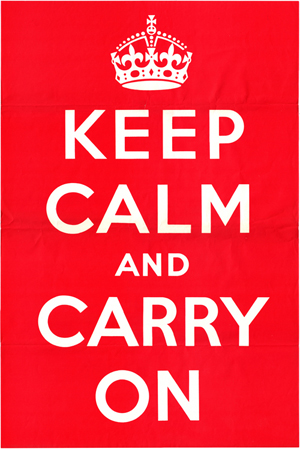 Pilots had the most critical and dangerous high-profile job but many Brits, male and female and young and old, pitched in. Many women worked in munitions and building planes. Gallup polls showed that, even in their darkest hour, nearly all Britons thought they’d persevere and fend off Germany, even as homelessness skyrocketed and criminals also took advantage of the Blitz. The “Blackout Ripper” murdered prostitutes with fewer policemen on the dark streets and crime rates soared as thieves exploded safes and broke windows undetected amidst the noise of the bombing. Just to keep their chins up, the Ministry of Defense made posters to boost morale in the event of German occupation. The most famous Keep Calm & Carry On incarnation reemerged in 2000 and some originals showed up on PBS’ Antiques Roadshow while variations proliferated in memes.
Pilots had the most critical and dangerous high-profile job but many Brits, male and female and young and old, pitched in. Many women worked in munitions and building planes. Gallup polls showed that, even in their darkest hour, nearly all Britons thought they’d persevere and fend off Germany, even as homelessness skyrocketed and criminals also took advantage of the Blitz. The “Blackout Ripper” murdered prostitutes with fewer policemen on the dark streets and crime rates soared as thieves exploded safes and broke windows undetected amidst the noise of the bombing. Just to keep their chins up, the Ministry of Defense made posters to boost morale in the event of German occupation. The most famous Keep Calm & Carry On incarnation reemerged in 2000 and some originals showed up on PBS’ Antiques Roadshow while variations proliferated in memes.
Supposedly, Germany never realized that the RAF was nearly at the end of their tether by the time Göring and Hitler gave up. At least that’s been English lore ever since. Recent scholarship based on simulation models suggests that the RAF wasn’t nearing defeat and that it was instead Germany who would’ve run out of planes within a few months.
